Text
Ojas, Tejas and Prana: Diagnosis with Nadi
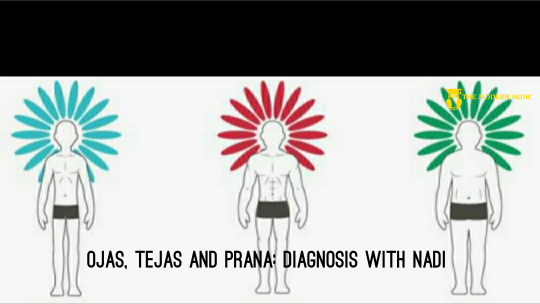
The body, mind and spirit exist together in daily life as a single unit just as all things in the universe exist together, in harmony. There are primal, magical, and subtle forces of energy within our bodies that are fluid and dynamic, called Ojas, Tejas and Prana. In reality we are consciousness, pure awareness, and our body is an expression of that consciousness. One way of achieving that pure awareness is to pay attention both to the outer object and the inner movement of sensation simultaneously in which the tan matras are revealed. There are five elements—Ether, Air, Fire, Water, Earth—and they each have respective tanmatras.
Sound is the subtle tan matra of Space
Touch is the tan matra of Air
Vision or sight is Fire
Taste is Water, and
Smell, the olfactory sense, is the subtle tanmatra of Earth.

So, these five elements are merged into five subtle tanmatras. An object stimulates the inner senses, through which the mind touches the outer object via the inner tanmatra. Through this bridge, we experience perception.
The Subtle Refined Essences of the Tissues
Our mind consists of five tanmatric substances. The external sound stimulates the inner tanmatra of the mind which enables the inner tanmatra to perceive the outer sound. There is also touch in our mind. We are constantly touching the outer environment through the sensation of touch - the air and objects. This outer touch through the skin stimulates the inner touch of the mental faculties. The examination of pulse is to be in contact with sparsha tan matra, which is nothing but the tactile sense of touch. In a way, tan matra is a vehicle. Our consciousness goes out with the tanmatra and touches the outer object of perception. So, the five tan matras of sound, sight, smell, touch and taste are used by Ayurvedic physicians, or vaidyas, in order to diagnose many problems. These five tan matras are our doors of perception, our innermost instruments of experience.
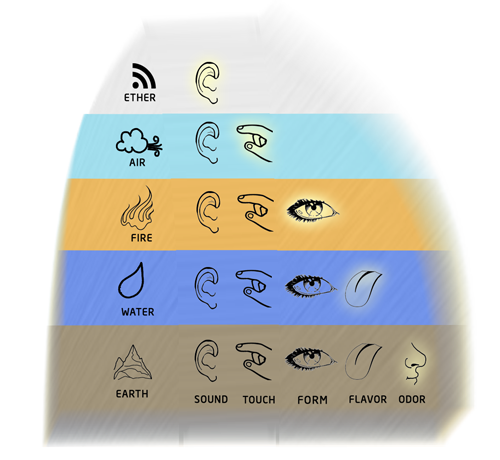
When we feel the radial artery, the pulsation corresponds to the heart-beat which is the center of the five tanmatras. The word “heart,” is not just the physical heart but also the center of the innermost being from which we perceive. In the cranial cavity there is the brain—the meninges, dura mater, arachnoid, pia mater, the grey matter and the white matter. Inside the core of this white matter there is space and there are small spaces between neurons called synaptic spaces. This synaptic space in between the neurons is functionally connected to the space within the brain called chidakash. Within that space is a pulsation of prana and a flow of ojas and tejas. Prana carries a sensation through the vagus nerve and the phrenic nerve into the cardiac plexus. In Sanskrit this pulsation is called prana spanda. Spanda, which is the pranic current from the hypothalamus to the heart, moves at intervals of .08 seconds and stimulates the pacemaker sinoatrial node, the SA node, which is present in the right atrium. From there the pranic stimulation is carried down to the AV node, the atrioventricular node. Thus, prana regulates the movements of the heart.

The heart is a type of battery. In its rhythmic movement the heart generates electricity that is carried through the blood vessels and even to the skin. This movement of cardiac activity can be traced with a sensitive galvanometer. So, pulse not only represents the heart pumping, but also represents the flow of prana and the flow of vyana. All the subtypes of doshas are moving in the subtle form of tanmatras. Let us focus on the fourth level of the pulse, which is the level of ojas, tejas and prana.

Ojas is the pure essence of all dhatus (tissues) and is produced during the process of nutrition. It can be compared to the modern concept of albumin. Ojas includes albumin but albumin alone is not ojas. Ojas also includes protein and globulin, which are necessary to maintain immunity. But to say that globulin is ojas doesn’t convey the-entire meaning. Ojas is an actual substance. Ayurveda has described ojas as two types. Inferior ojas is half anjali, which moves throughout the body, and superior ojas is eight drops, which is present in the heart. This ojas has the smell of ghee and rice. It is a little yellowish-white in color, cool in attribute and tastes like honey. Ojas moves through the plasma and is represented at the fourth level by the pulsation under the ring finger, the kapha finger.
Tejas can be compared to hormones and amino acids. There are 21 important amino acids that regulate cellular metabolism. Tejas is necessary for pilu paka and pithar paka, the agnis of cellular and nuclear metabolism. Tejas is also responsible for intelligence, understanding and comprehension at the cellular level. It is felt under the middle finger at the fourth level. Every cell is a center of awareness, every cell has a consciousness, and every cell is a unit of life. At one time each of us was an atomic cell. From that one atomic cell, the sperm, or the ovum, which is also unicellular, a complex multi-cellular mammal developed.
There is a continuous flow of communication between any two cells of the body and that flow of communication is called prana, the flow of intelligence. The prana spike is found under the index finger at the fourth level. When feeling one’s own pulse, the right-hand pulse in the male and the left in the female, gently touch the superficial skin and feel the throbbing at the first level. Go down slightly and feel the spike change at the second level. Then at the third level the spike changes again. With a delicate pressure go into the fourth level where the spike once again changes. At that level feel the strength and quality of the spike.
A spike under the kapha finger denotes the strength of ojas. The middle finger gives the power of tejas and the index finger gives the strength of prana. When the spike is weak, prana is weak; when the spike is strong, prana is strong. In the same way, if the spike under the middle finger is feeble, tejas is low; if the spike is strong, tejas is strong. Detecting these differences varies from person to person. Three plus (+++) is good ojas. Two plus (++) is moderate ojas. One plus (+) is very low ojas. One plus is 25 percent, two plus 50 percent, three plus 100 percent. One hundred percent, the superfine quality of ojas, is present in a perfectly healthy individual. Now feel the pulse, bringing all tanmatras to the tip of the finger. Ideally, ojas, tejas and prana should be equal—three plus—and that is good health. However, we work hard, we have. troubling emotions, we have responsibilities, and all these stresses decrease a person's ojas.
In certain AIDS patients a very feeble ojas pulse is present, because their ojas is depleted. If tejas is four plus, that is too much and high tejas bums ojas. For example, in a person suffering from multiple sclerosis, high tejas burns the myelin sheath, which is composed of ojas.

There is condition known as demyelination which leads to multiple sclerosis. This is the reason why patients of multiple sclerosis get exhausted when exposed to too much cold or hot weather. Both heat and cold bother them. So, four plus tejas is abnormal. Four plus ojas is too much ojas and too much ojas is raw ojas, which creates diabetes and may lead to high cholesterol and high triglycerides. High prana makes a person disorganized and anxious. Ojas is the pure essence of kapha, tejas is the essence of pitta, and prana is the essence of vata.
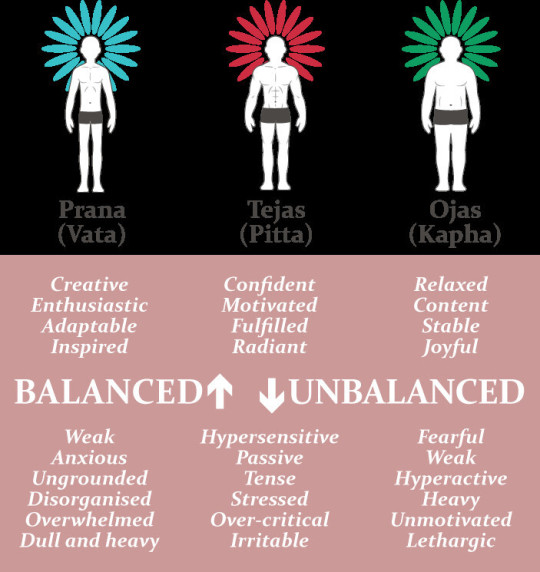
Treatment of Depleted Ojas, Tejas and Prana
Depleted ojas can be treated with almond milk-
Soak 10 almonds in a cup of water overnight.
In the morning peel off the skins and put the almonds in a blender.
Add one cup of hot milk. If the person is allergic to milk, use soy or rice milk.
Add one teaspoon of date sugar, a pinch of cardamom, a pinch of ginger powder and one teaspoon of ghee and blend together. Regular brown sugar or turbinado may be used instead of date sugar.
Saffron along with a few drops of rose essence may also be added.
This is a wonderful, rich drink to take in the morning to build up ojas. This drink is also good for building shukra after having sex. If cholesterol is a concern, use skim milk. Ghee increases the good cholesterol, called HDL, but if one’s total cholesterol is high, avoid taking ghee. By using certain Ayurvedic herbal formulas, one can improve ojas-
Pippali (Piper longum) with honey and ghee is a specific rasayana for prana.
Taking one-fourth teaspoon of triphala with one teaspoon of honey and ghee will help to create balance of ojas, tejas and prana. Early morning is the best time to try this formula. Further, one should not fear that this will lead to increased cholesterol levels, because honey aids the regulation of cholesterol. Additionaly, shambhavi mudra helps to balance ojas, tejas and prana.
(70) Yoga For Inner Exploration: Shambhavi Mudra - 5 mins #MeditateWithSadhguru - YouTube
For depleted tejas-
- Use one pinch of trikatu (ginger, black pepper, Piper longum) and one teaspoon of honey.
- Take this combination about 15 minutes before lunch and dinner.
These herbs taken before food kindle agni and act as an appetizer along with heling in improved digestion as well. Chewing a small piece of ginger with a pinch of salt and a few drops of fresh lime juice before eating will also kindle jathar agni thereby building tejas. Castor oil is beneficial for vata and, therefore, good for prana. But to build up tejas, castor oil would not be a good idea. Bitter ghee, tikta ghrita, is good for tejas. Tikta ghrita enhances tejas but doesn’t increase pitta. Take one teaspoon on an empty stomach twice a day, morning and evening, followed by half a cup of warm water. In order to improve prana, do pranayama-
Sit comfortably on the floor in a cross-legged posture.
If you are not comfortable in this position, then sit upright on the front edge of a chair with your feet flat on the floor.
Close the right nostril with the right thumb and inhale gradually through the left nostril into the belly, not into the chest.
During inhalation, count 1-2-3-4. After a full inhalation, close both the nostrils and do a gentle chin lock as you hold the breath in the belly and count 1-2-3-4, up to 16.
Use a counting pattern of 4 to inhale and 16 to retain. Then open the right nostril while holding the left nostril closed with the ring and little fingers and exhale through the right nostril while counting till 8.
This exhalation should be slow and steady as you count 1-2-3-4- 5-6-7-8. The speed of counting should be constant, viz a count of 4 for inhalation, 16 for retention, and 8 for exhalation.
If this approach is too complicated or difficult at first, then inhale only for 2, retain up to 8, and exhale for 4 counts.
After exhalation from the right nostril, hold the breath outside for a while then inhale through the right nostril, hold the breath into the belly by closing both nostrils, hold, and then exhale through the left nostril.
Repeat, alternating the nostrils through which you inhale. If the mind is, too busy with the counting, just inhale slowly into the belly through the left nostril by closing the right nostril.
Try to focus your attention behind your belly button. When oxygen is depleted in the lungs, one gets a swallowing reflex, which is a sign to exhale.
Then slowly exhale through the opposite nostril. During exhalation there should be a continuous slow flow.
Let the air dissolve into the outer space. Stay outside for a moment, then again inhale.
Inhale through the right nostril, retain, and exhale through the left.
Inhale through the left, retain, then exhale through the right.
During breath retention do a chin lock and during exhalation release that lock. You use a chin lock to avoid direct pressure in the brain through the carotid artery.
Do five pranayama, rest for one minute, then again do five pranayamas. In this way the vital capacity of the lungs can be increased.
Another pranayama is bhastrika, breath of fire. Inhalation is passive, but exhalation is active with a little force-
- Start slowly, then increase the speed.
- Imagine a steam engine moving slowly and then have the train start moving faster. This action is thoraco-abdominal hyperventilation.
- Do one round of 30 strokes or exhalations, then rest for one minute. This pranayama will also increase the vital capacity of the lungs.
- Practice five rounds of bhastrika in the morning and five rounds in the evening. It will help to relieve allergy, asthma and will help make the lungs strong and healthy. Don’t do bhastrika during menstruation or pregnancy. If your pitta is high, substitute shitali, a cooling pranayama that involves breathing through a curled tongue. Another pranayama is called bhramari (humming). On inhalation, constrict the epiglottis and create a humming sound. On exhalation the sound is long and low.
The inhalation is a female bee and the exhalation is a male bee. If it is difficult to create a humming noise during inhalation, just inhale naturally, take a deep breath into the belly, do a chin lock and then do bhramari on the exhale. Bhramari improves the melody of the voice. In addition, the humming vibrates the nervous system and is a form of sound therapy for the brain. Bhramari is also good for the thyroid, thymus and parathyroid glands. When doing bhramari, touch the tip of the tongue to the edge of the soft palate near the back of the roof of the mouth and be sure the teeth are not clenched. Bhairavi mudra is also called shambhavi mudra. Shambu is another name of Lord Shiva. In this state prana is enhanced. One can strengthen prana with pranayama through bhramari and bhastrika but intense prana unfolds in the lungs and body through bhairavi or shambhavl.
One who practices shambhavi will be in a state of living samadhi. When practicing the bhairavi mudra, one looks at any object, say a wall. When looking at an object, let the eyes look and do not blink the eyelids. The eyes are looking and the eyes are not looking, which means there is no judgment,' no recognition, no identification. In Hindu art, philosophy and music everything is a way to God-realization. Hindu philosophy includes the Vedas, Ayurveda, music, art and even dance. Everything is a movement of life. Therefore, the Hindu concept of God is satyam shivam sundaram. Satyam is the truth, shiva the holy and divine and sundar is beauty. Bhairavi manifests as satyam shivam sundaram. As one looks outside, suddenly the attention goes inside. At that moment expansion of consciousness takes place. One is looking outside but the entire attention is inside, into the center of existence. In that state one finds union with expansive consciousness. One looks around, but there is no choice in the looking, no judgment, just choiceless observation. In this sense the choosers are the losers.
The confused mind chooses. The mind that is insecure, agitated and unsatisfied chooses. Please don’t misunderstand me. I am talking about a different level of consciousness. In this art of meditation choice has no place. Choice only has a place in that one has chosen this way of meditation, that’s all. Look at anything, but in that looking there is emptiness. Thinking stops, breathing becomes quiet and one simply exists as pure awareness. In that state there is great joy, beauty and love. Sit absolutely relaxed, with no tension, and just look at the wall. Slightly open the mouth with no expression on the face. The hands are like an empty bowl facing the sky. Simply look and allow the breathing to become quiet. Enlightenment can come in a fraction of a second.
Wherever the eyes and mind go, there is samadhi. Samadhi means equilibrium. In that state, individual consciousness merges with cosmic consciousness and one goes beyond time and thought. In that state, whether the eyes are open or closed doesn’t matter. It comes like a breeze without invitation, because this state is your true nature—love, become spontaneous and natural and will balance ojas, tejas and prana. We all need healing. We, as individuals, must bring awareness to our feelings and emotions. Otherwise, we never take responsibility for our healing. We always hold another person responsible for our suffering—Either mother, father or some planets in the sky. We need to accept the responsibility that “I am the pain and the pain is I. My pain is my creation; it is my reflection; it is I.”
We must understand our relationship with our suffering and, in that understanding, we maintain our ojas. In that ojas there is the beautiful light of tejas, which is the perception. And in the flame of attention, grief and sadness burn and we become totally free. We have to protect our ojas, tejas and prana through awareness, because awareness is the flame of attention and the flame of attention is the luminosity of tejas. Prana directs attention to something, creating perception. Attention plus prana is perception. There are many things waiting for our perception, but we cannot perceive everything at one time. Perception is a product of time and our perception is a learned phenomenon, which is directed by knowledge and experience. In the perception of observer, object and observation, this trinity becomes one when ojas, tejas and prana are balanced. This balanced state is perfect health.
When we are honest with our feelings and emotions, ojas is building, tejas is glowing, and prana is flowing. That is a state of good health, existing at every moment, in every event of life. Ayurveda says every breath, every moment, every event should be lived with total awareness. When listening to someone, at the same time listen to the listener. When looking at an object, at the same moment look at the looker. When you look at me, my body is an object and you are the observer. When I am looking at you, your body is the object and I am the observer. When you look outside, something goes out, one arrow goes out. At the same time, a second arrow goes into the heart to look at the looker. This is called double-arrowed attention.
Read the full article
7 notes
·
View notes
Text
Astrology of Money and Market
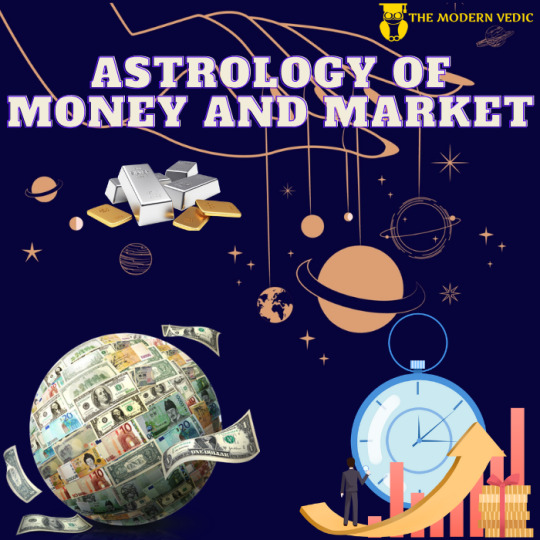
People are attracted towards business and financial astrologers for a number of reasons. It has been often observed that conventional business houses seek the assistance of their family astrologers. They not only foretell future of their family but also help in getting profitable deals in the market, fetching large amounts of money at auspicious moments.

The merchants of contemporary time, also observe some incredible prophecies of commercial astrologers from time to time. Subsequently, they try to combine them with the conduct of the goods or commodity markets. They also uphold

these predictions in analyzing the market trends. Commercial astrology, besides indicating market inclinations and fluctuation in prices of diverse commodities, also forecasts the fortunes or circumstances of business concerns. The reason for hatred of the various facets of astrology, especially the expansion of the firm, are two-fold. Firstly, there are very few explanations available in the scriptures and the modern writings. Secondly, the adequate and sufficient astrological data about any firm is never recorded (completed).
Vedic Astrology is ancient Jyostish Shastra' of India. The origin of the words indicates Jyoti as a Divine Light and Tisha' as science. The science of divine light. Similarly, 'Astro' denotes 'Stars' and indicates astrology as the science of the stars or heavenly bodies. The sages and seers are practicing Jyotish from time immemorial. The corresponding terrestrial events and celestial objects bear ample of references in our ancient teachings.
Astronomy, Horoscopy and Samhita are some of the components of Jyotish. The meaning of Samhita is compilation. Therefore, it is way of condensing scriptures and works of a subject. It garners the astronomical treatises that are connected to human affairs.
As per the astrological concepts, prosperity is hard to come unless material gains are promised in the natal chart of an individual. A person has intense desire to live a comfortable and blissful life. However, wealth does lead a dominant part in furnishing the cheerful life style, on which the past actions of the individual, have a huge impact. Apparently, this is taken as a result of one’s own efforts.

Everyone has the right to articulate his anxiety differently and eagerly to know about his/her material prosperity and financial successes. But the wealth does not always manifest satisfaction even though people fly after it. Mental peace and bliss cannot be attained through abundant richness. Still, many pursue the money matters with great energy and passion. It is considered as a most potential strength and impregnate power of the material world. People often get confused to determine their real goal in the wake of this hallucination.

However, wealth and riches to the native are governed by specific celestial laws. The horoscopes indicate origin and time of acquiring wealth. The person enjoys a status emanating from the cosmic rays of the sun. Whereas, the moon generates the creativity for the person. The positioning and inter-influence between the celestial bodies in harmonious houses, design most powerful amalgamation of riches.
The wealth chart expresses unequivocal opulent effects due to the configuration of heavenly objects. The basic principle is that the houses above the horizon have much greater influence. They illustrate the prosperity provided the planets occupying these houses do not mitigate their power. The wealth is assigned to 2nd and 11th houses irrespective of power and influence. The 5th and 9th houses signify investment and destiny. The Lords of these houses initiate the possible methods for gaining wealth and riches. These possible avenues are acquired through a series of permutations and combinations. The method of sourcing wealth is determined by the status and intrinsic qualities of the planets.
The lord of the 6th house represents wealth. It sometimes intervenes into the association of planets representing wealth. This interposition procreates or multiply gains through share markets, lotteries and other recreations. The acquisition of wealth and gains through inheritance or fortune are related to the Lord of the 8th house.
The 2nd house (Dhan bhav or monetary feelings) and the lord of the 2nd house are indicated as Dhan karaka (monetary solution). Eventually, they get influenced by each other in the transition period. This transformation creates the right time to acquire wealth. However, the fast-moving planets during the transit, procreate a frequent conjunction.
The relevancy of dhan yogas in the business astrology are often determined. Both the vedic and western astrology contains the components of generating wealth. Jaimuni Sutrams is one of the classical scriptures containing Dhan Yogas. Whereas, fortunes were cited in the western astrology.
Electional astrology or Event astrology is another dimension of astrology. It involves an effective role in structuring the success of a well planned venture. Therefore, it is necessary to start a venture at an auspicious moment in order to harness the cosmic energies for one’s advantage. Every human activity on earth seeks divine support.
Electional astrology has concluded enormous significance in past as well as in present day life. Its importance is observed primarily because even a person is equipped with all skills of trade and knowledge of market intelligence may fail. Therefore, it is required to take a plunge at a right time to start a particular work. It imparts great confidence and also eliminate anxiety of uncertainty.

Time is a never ending and immeasurable concept. Cosmic forces design every object in the nature at a right time. These objects are created for a certain length of time and dissolve at an assigned time. To understand this phenomenon, it is necessary to comprehend the cosmic currents that affects the recurrent activities. The cyclic functions of creating, developing and destroying are regulated by the vibratory energies of nature. The vibratory energies emanating from the celestial bodies greatly affect the proceedings related to life cycle.

The Sun dominates the solar system and unites energies. It also acts as a prime force governing the process of life. The elected time for a specific event is auspicious in harnessing positive vibratory energies. These energies counter all the evil forces and guarantee success in the venture. Electional astrology is simple and serves a very useful purpose. Nakshatras or constellations are the key factors in Electional astrology. Terrestrial modifications are the manifestations of celestial occurrences. The field of Mundane matters makes these modifications more noticeable. The planets are limited to terrestrial matters with main emphasis on the commercial activities such as bullion, stock market and other business concerns.

In mundane astrology, it is important to consider trans-Saturn planets. Uranus, Neptune and Pluto assume greater power in mundane astrology. Their effects remain for much longer duration as they are distant, slow moving and weighty planets. They form an integral part in determining the commercial activities apart from terrestrial affairs. The heavy outer planets create fluctuations in the market for long term. While, minor planets cause short term market effects. Venus and Mercury often destabilize the market but for a short period. The eclipses caused by the Sun and the Moon, greatly influence the market functions. It is more relevant to call it 'market trends' as the effects can be seen after months and persist for years.

The configuration of major planets and the event of eclipse impel far reaching consequences. For instance, the world witnessed a total lunar eclipse on 1st and 2nd September 1997. It was visible in Asia as well as in India. The major planets like Jupiter, Uranus and Neptune remained in Capricorn sign. Major stock exchanges experienced severe drops in the indices of the nations like South East Asia, like Japan, Hong Kong, Singapore etc. India was no exception. The currencies of these countries fell down as compared to American dollar. Therefore, movement and association of outer planets along with eclipses has to be closely observed.
Generally, 12 noon time is considered as a time of formation of the company. This is the time when the Sun is at zenith and bestows positive vibratory energies with huge intensity. When a company is incorporated and assumes an autonomous status, it creates a cosmic figure of that epoch. A chart like a natal horoscope is erected to asses the company’s new venture or expansion.

As discussed above, 1997 was a significant year and had some noteworthy events. One of the astronomical explanations was the grouping of three major planets. They remained in Capricorn sign throughout the year and India is in the ambit of this sign. On 9th January 1997, a Jupiter-Neptune conjunction was observed. This was followed by the Jupiter-Uranus conjunction on 16th February 1997.
Jupiter is a planet of expansion and prosperity while Uranus brings immediate and sudden changes. The market prices experience abrupt fluctuations due to the evil nature of Uranus. However, disintegration and chaos are attributes of Neptune.
The Grouping and then the conjunction had set the blend of the markets. In January 97, BSE Sensex index first rose up followed by a decline and then again climbed to 4568 points. On 6th august 97, the Sensex was registered at 4646 points. Thereafter, on 11th December 1997, a decline was observed and the Sensex index plunged to 3320 points. The gold prices, at one time of the year were at 12 year low and remained subdued in 1997. Whereas, silver prices experienced buoyancy and crossed $221 in 97 and then touched low values creating confusion between traders and consumers.

The unexpected performance of the above three markets including gold have illustrations in the cosmic laws. The planetary conjunction and features formed during that epoch have supported the market trends. Therefore, market fluctuations fall in the ambit of cosmic laws and astrological precepts.
Read the full article
6 notes
·
View notes
Text
Yoga for Rheumatoid Arthritis

When we hear the word, 'Arthritis', the picture of our old relatives with joint pain immediately comes up in our mind. But Arthritis is certainly not an 'elderly' condition. In fact, there are some types of arthritis, which appear in young and middle-aged people, and an example of this is rheumatoid arthritis. The Young and middle-aged people, are more prone to this form of arthritis because of their hectic and super-fast lifestyles. Studies have shown that practicing a few yoga poses on a daily basis, can help avoid all painful and stress-full symptoms of Rheumatoid Arthritis, for people of all age groups.
These poses influence the different joints and organs of the body and ease rheumatic pain. Though they seem very simple they have subtle effects on the practitioner. Therefore, this group of exercise is sukshma Vyayama in Sanskrit, meaning the 'subtle exercise'.
Yoga Poses for Rheumatoid Arthritis
This series of asanas should be performed at the beginning of the daily asana session to loosen the joints and make the muscles supple and relaxed. They are also intended for beginners and for those who are weak or sick, as well as for people with heart problems or high blood pressure or stiffness in the body. Before starting Yoga asanas for rheumatoid arthritis, practice shavasana to relax physically and mentally.

Lie flat on your back, legs separated with hands on your side, palms facing upwards. Try to loosen all your muscles and joints. Become free of every kind of tension. Feel your body; become aware of your breath. You are relaxing. Observe your breath for sometime. Ensure that it is natural and spontaneous, unforced. Count your breaths. During the practice of counting the breaths do not suppress any thoughts. Watch them as a witness, without being emotionally involved with any of them. Your main concern is to relax the whole mind and body. For the time being forget all your worries, anxieties and worldly problems. After a few minutes slowly move your arms and feet and sit up. Now you are mentally and physically prepared to start Yoga for rheumatoid arthritis.
Toe Bending
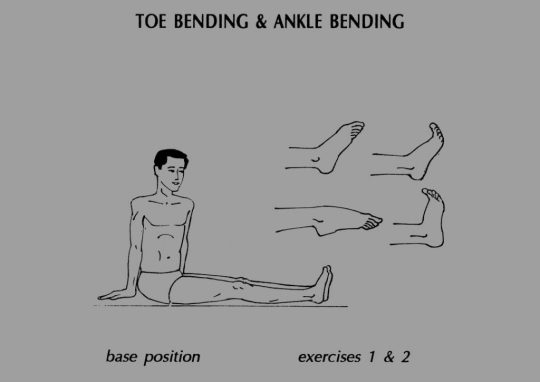
Assume the base posture with legs stretched directly in front of the body.
Place the hands on the floor by the side of the trunk.
Lean backward taking support on the straight arms.
Become aware of the toes.
Move the toes of both feet slowly backward and forward, keeping the feet rigid.
Repeat 10 times.
Ankle Bending
Remain in the base position as in exercise 1
Move both feet backward and forward as much as possible, bending them from the ankle joints
Repeat 10 times
Ankle Rotation

Remain in the base position as in exercise 1
Separate the legs, keeping them straight
Keep the heels in contact with the floor
Rotate the right foot clockwise from the ankle 10 times
Rotate the right foot in the same way but anticlockwise 10 times
Repeat the same procedure with the left foot
Then rotate both feet together
Ankle Crank

Assume the base position
Place the right ankle on the left thigh
With the assistance of the left hand, rotate the right foot clockwise 10 times, then anti-clockwise 10 times
Repeat the same procedure with the left foot
(i) Knee bending

Assume the base position
Bend the right leg at the knee and clasp the hands under the right thigh
Straighten the right leg without allowing the heel or toe to touch the ground
Keep the hands under the right thigh but allow the arms to straighten
Bend the right leg as much as possible at the knee, bringing the heel near the right buttock
Repeat 10 times
Now repeat the same procedure with the left leg.
(ii) Knee crank
Assume the base position
Instead of stretching the right leg, hold the thigh near the trunk and rotate the lower leg in a circular motion from the knee
Do this 10 times clockwise, then 10 times anti clockwise
Repeat the same procedure with the left leg
Dynamic Spinal Twist
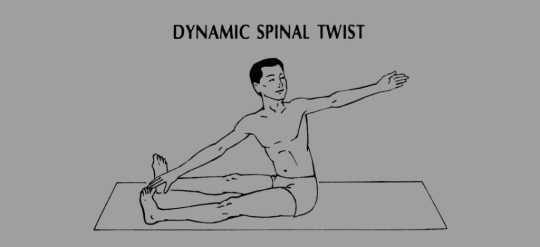
Assume the base position
Separate the legs as much as possible.
Keeping the arms straight, bring the right hand to the left big toe and stretch the left arm behind the back
Keep both arms in one straight line
Turn the head and look in the backward direction, directing your gaze towards the left hand
Turn the trunk in the opposite direction. Bring the left hand to the right big toe and stretch the right arm behind you
This is round one.
Repeat 10 or 20 times
At the beginning, do the exercise slowly, and then gradually increase the speed
Variation: If the practitioner wishes, he can try to separate the legs further without bending them, and then repeat the entire exercise.
Half butterfly

Fold the right leg and place the right foot on the left thigh
Place the left hand on the right foot and the right hand on the top of the bent right knee
Gently move the bent leg up and down with the right hand allowing the muscles of the leg to relax as much as possible
Repeat the same process with the left knee
After some days or weeks of practice the knee should comfortably rest on the floor without effort
Knee Rotation
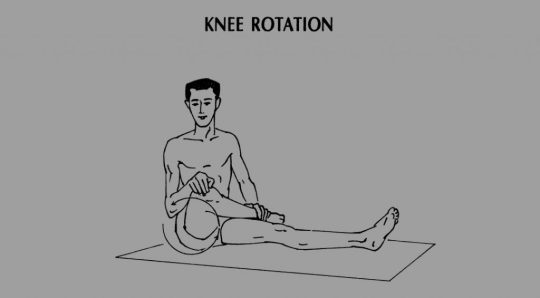
Remain in the same position as in exercise 7(Half Butterfly) but hold the right foot with the left hand
Rotate the right knee in a circle, trying to gradually make the circle larger
Do this 10 times in the clockwise direction and 10 times in the anti-clock wise direction.
Repeat the same procedure with the left knee.
(i) Full butterfly

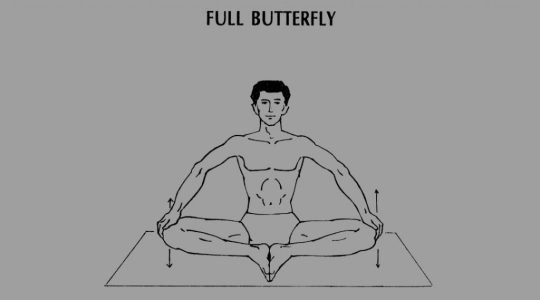
In the base position bring the soles of the feet together.
Try to bring the heels as close to the body as possible. Interlock the fingers and place them under the feet.
Gently push the knees towards the ground, utilizing the elbow, and bend the body forward.
Try to touch the ground with the head. This will be difficult at first, but with time it gets easier.
(ii) Full butterfly
Keeping the soles of the feet together, place the hands on the knees
Utilizing the arms, push the knees towards the ground, allowing them to bounce upward again
Repeat 20 or more times
(iii) Full butterfly
Maintain the same position but place the hands on the floor behind and to the side of the back, keeping the arms straight.
Move the knees up and down 20 or more times.
Crow walking
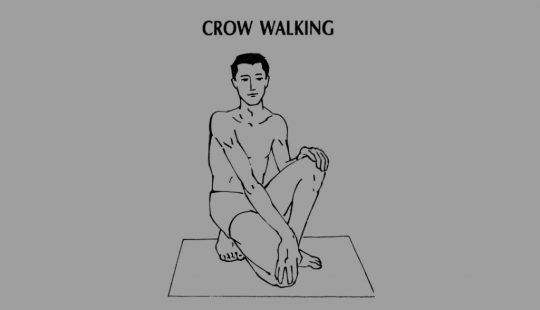
Squat on the floor
Place the palms of the hands on the knees and begin to walk in the squatting position
One can either walk on the toes or the feet. Choose whichever is most difficult
Do this exercise for a short time without strain
Crow walk touching the knee to the ground with each step
This is a very good exercise to prepare the legs for meditation poses. It is also recommended for people with poor blood circulation in the legs. Constipation sufferers will find this exercise useful. They should drink 2 glasses of water and then crow walk for one minute. Drink 2 more glasses of water and crow walk again. Repeat these 3 or 4 times. This should ease the constipation.
Read the full article
#arthritis#blood_circulation#constipation#heart_diseases#heart_issues#high_blood_pressure#joint_pain#joints#pain#pain_relief#subtle#yoga
12 notes
·
View notes
Text
World View in Shaivism

Shaivism philosophy has been recognized as the best among all the Sadhana Paths that lead to self-recognition. According to this system mind is to be withdrawn from objective activities and turned towards the subject, which is the real self and has to be merged into it. We bow to that Samvit Devi i.e. Shiva's coordinating force or cosmic energy that is transcendental (independent of experience) and immanent. She is a quintessence of Shiva and is blossomed / projected into this universe through the manifestation of the divine shakti.
The Shaivism philosophy teaches us that this entire world is the play of consciousness. Thus, one does not have to undergo any kind of difficulty to attain God. Forgetfulness of one's true nature is the mass of ignorance which veils the experience of the self. All scriptures and Sadhanas are simply washing away the filth of ignorance. They have no ability of their own to reveal the wisdom of the self because that principle is self-existent, perfect and always manifest.
When a seeker becomes worthy of attaining the absolute, his mind becomes unshakable and contended. A fountain of joy wells up in one’s heart when one's awareness becomes stable. He looks upon everyone with love and understands the following:
Harsh words are a sign of inner dryness.
Self-praise is evidence of non-attainment.
Cruelty is a proof of hatred.
The idea of difference indicates the cancer of ignorance.
Living in the midst of people, the seeker loves all but remains independent of everyone. He gives up all expectations.
The principal scriptures of Shaivism philosophy are the Shiva Sutras. These teachings were revealed by Shiva and were kept hidden till the great Vasugupta disseminated them throughout the world. The Shiv Sutras describe three upayas or means of Sadhna i.e.
Shambhava upaya
Shakt upaya
Anava upaya
Shambhava upaya is the belief that the world is the embodiment of Shiva.
The Shakt upaya is the process by which the mind and intellect completely merge into the inner self.
The anava upaya is a dualistic as well as non-dualistic path because it leads to unity. It involves the use of body, mind, intellect, senses and Prana Shakti.
Through Japa, meditation and other dharanas a person becomes one with Siva and attains peace of mind. We do not need to know the scriptures to recognize our parents. Once our mother shows us who our father is, we do not have to mediate on him incessantly or repeat the mantras of his name. We always know him. In the same way at the precise moment when one recognizes the inner consciousness, as prakasha and vimarsha one becomes perfect. This is the Anupaya or Guru-Kripa-upaya - the path of Guru's grace. This upaya depends on seekers worthiness. Prakasha (light of consciousness) or Vimarsha (its awareness) are the two aspects of Param Shiva. Prakasha is Shiva, the static aspect, which similar to the nature of light.
Vimarsha is the dynamic aspect or Shakti through which Param Shiva is able to survey Himself, and cause manifestation and dissolution. Param Shiva or Para Sammvit contains various powers and its nature of consciousness, is the supreme principle.
As per the first Shiva Sutra, "The self is consciousness". In truth there is nothing other than that conscious light, which is the ultimate Reality. This world is the play of that Principle - the universal consciousness. Param Shiva Himself, by contradicting his own will brought about the effects of three impurities:
Ang mala, is ego.
Maya mala, is differentiation.
Karma mala, refers to the activities of virtue and vice.
Enveloped in these three impurities, the individual soul falls under the influence of the letters or sound syllables, which are the basis of words. From these letters arises language, from language come ideas and from ideas comes understanding. The understanding derived from many factors, which contributes to the functioning of a human being, his body, his senses, his mind and various gross and subtle principles takes a form so that others can understand it. These letters arise from a source known as the matrika chakra. From the gross body to the matrika charka there is nothing but a group of powers and shakties. Shri Swami Vidhyadhar Ji in his hymn to Goddess Saraswati has described it like this:
The physical body, which is made up of five elements, has to be understood fully so should the purishtaka or subtle body, which is composed of five tanmatras along with the mind, Ego and intellect. One should also understand the gross and subtle principles from Shiva to the Earth.
According to the Shaivism philosophy, the universe is a form of Shakti, the supreme principle. Shiva and Shakti are one, they are not separate. A person, say a "Yogi", who has attained perfection considers the universe to be the light of his own self like the light produced by a flame. The knowledge of one's true nature (Aham-I) and the knowledge of the universe (idam - this) merge into an all-pervading unity. This is the understating that one should have. The knowledge of "l" is like a flame and the knowledge of "this" is like its light, which spreads everywhere equally.
This universe of ordinary experience contains infinite permutations of consciousness such as in the form of manifestation of the material of the world. Nila blue is among the countless colors and forms that make up the objects perceived through the outer senses.
Similarly, Sukha (pleasure) is one of the many experiences of inner senses. Deha (the body) is the basis of the both inner and outer experiences. Para - vital force is one of the many conscious powers that makes the body function. This way the universe is full of numerous forms. Secondly, these are called Pramana (means of knowing) Pramata (the knower - subject) and Prameya (object of knowledge-object). Shiva is both the means and the end. No other light is needed to reveal light, it reveals itself and other objects as well.
Similarly, consciousness reveals its own nature and also gives us the knowledge of other objects. It is called Para Samvit, Param Shiva or Chetanaya. Param Shiva is as serene as a still ocean. In this state Shiva is transcendent (independent of experience). He is always filled with bliss. In his immanent aspect through the independent power of the supreme I consciousness, Param Shiva becomes the thirty-six tattavas and reveals the seven experiences from within Himself.
Main aim of Jeeva (individual soul) is to, Bring self-consciousness together. Simple individual is known as (to whom all the three malas (coverings mentioned above) arise. After passing many trans-migrations or births an individual gets awakened to the knowledge of the identity of the soul with the supreme spirit. In case he still does not get awakened and gets entangled in cheap activities he remains bound by the fetters of malas (coverings) and the universe. When he throws out all the three malas then eternal ego merges and remains in "शिवम्य आत्मा स्वरूप" Being constantly in this state, he gets perfection.
To conclude, there are three paths to reach to the ultimate reality:
Devotion
Knowledge
Renunciation
But, these three are meaningless without the guidance and grace of the Guru (called Guru Kripa).
Bimba Pratibimba (Doctrine of Reflection) in the Shaivism Philosophy
Bimba Pratibimba is one of the most wonderful principles of Shaivism philosophy. The universe is reflected in Parmeshwar who is Sat-Chit-Anand. Bimba infact is Pratibimba, the object and its reflection are identical. Shiva is the world and the world is in Shiva. Shiva and the world are not two but one. The principle of Bimba is true knowledge
निरमलं मुकरं यद्वत् भान्ति भूमिजलादयः।
आमिश्रास्तवत् एकस्मिन चिन्मात्रे विश्व वृतयः॥
Just as water, earth, etc. are reflected in a clean mirror without intermingling, in the same way the entire world is reflected in one God an embodiment of consciousness. The world, which we experience, is conglomeration of five elements. The human body is an epitome of objectification of the universe composed of five elements and all objects of the world have sprung from them. If we keenly refer to the elements described in Acharya Khem Raj Para Preveshka, we find these five elements referred to as space, air, fire, water, earth. These elements have five qualities viz. sound, touch, form, taste and smell.
Every material object has these five qualities. A person has five senses to perceive and to reflect the corresponding qualities. Sound is reflected in the ears, touch in the skin, form in the eyes, taste in the tongue and smell in the nose.
However, the senses do not have the power to perceive them independently. For this our senses need the help of the four psychic instruments and along with the Chit Shakti. As the strength of each sense increases, the objects are reflected and perceived more clearly and in finer detail. Yogis feel and perceive their finer qualities through "Sadhana". They have thus sharper and clearer senses of perception. A reflection appears in a mirror or on a clear surface.
The mirror and the object reflected in it are different from each other although they do not appear to be so. Whatever be the size of the mirror, the reflection does not undergo any change, its size remains the same. Moreover, even if many objects are reflected in a mirror, they do not intermingle with one another e.g. fire and cotton may be reflected simultaneously in the same mirror, similarly cow and lion are reflected in the same mirror, the cow is not afraid of the lion and the latter does not attack the former. So, they do not intermingle with one another. The cleaner the mirror or say the surface is, the clearer the reflection will be.
Importantly, if something is to be reflected, there must be an object, and that object must have a form. We see our face in a mirror but we cannot see the mirror in our face. Therefore, we can say that the face lacks the clarity to reflect. This is the case with the relationship between the external world and God. God revealed the world to us but the world can't reveal God.
Therefore, we reach to the conclusion that, clearer our heart becomes, brighter will be the reflection of Shiva. In the case of mirror, there is an external object that is reflected, and in the case of universal consciousness/ Parmeshvera, it is its own ideation that is reflected. In the case of a mirror there is external light due to which reflection is possible but in the case of universal consciousness it has its own light, it does not require any external light. It is the light of all lights. Moreover, the mirror being non-consciousness does not know the reflection within itself. On the contrary the universal consciousness is self-conscious. Acharaya Yog Raja Analyses this in Parmarthsara as:
अन्तर्विभाति सकलं जगदात्मनीह।
यद्वत् विचत्र रचना मुकरान्तराले।।
बोधः पुनर्निज विमर्शन सारयुक्तया।
विश्वं परामुशति नो मकुरस्तथा।।
Just as a variety of objects appear, within a mirror, even so the entire universe appears within consciousness or the self-consciousness owing to its Vimarsha or self-consciousness knows the world, but in the case of a mirror it does not know its objects. When we use the energy of an object and its reflection, we speak of a mirror as the basis of its reflection. That which is being reflected is separate from the mirror, but when it is seen, it is called a reflection.
Thus, three things are involved, an object, its reflection and a mirror. When applied to God and the Universe these are not three separate entities. Shiva or consciousness is all the three - the object, the reflecting instrument, and the reflection. Shiva is the object and the universe is His reflection. The pain and pleasure, which arise in our lives, are experienced in two ways. One through inner remembrance and another through the perception of outer objects. This is the result of the vibration produced by our sensory perceptions. This pain and pleasure are reflections of some of the five qualities of the elements.
These reflections cause a vibration in our sensory perception, which in turn produces involvements such as anger and desire. Once these tendencies merge into our Chitti, you will no longer experience any pain or pleasure. An enlightened being does not become attached to momentary pain and pleasure. He realizes that they are mere reflections.
मत्रास्पर्शास्तु कौन्तेय शीतोष्ण सुख दुखदाः।
आगमापयिनीऽनित्यास्तांस्तितिक्षस्व भारत ।
-Bhagwad Gita II - 14
O, Son of Kunti, the contacts of the senses with their objects, which cause heat and cold, pleasure and pain, have a beginning and an end. They are impairment. Endure them bravely, O Arjuna. Everything that we know is simply a reflection. Whether it is an inner experience or the perception of outer objects, it cannot be anything other than a reflection. By contemplating these reflections, which are the source of duality, we understand the differences between them and the experience of our true nature, which leads to all pervasive unity.
The understanding of the principle of Bimba Pratibimba In Shaivism Philosophy is very helpful in attaining this experience. Through it we learn to reject reflections, which are the cause of pain. When we have a firm faith that the universe is a reflection into Chiti and attachment and aversion are just in our consciousness, we attain the bliss of consciousness.
Read the full article
14 notes
·
View notes
Text
True Knowledge in Vedic Philosophy

What is True Knowledge ?
In the 21st century, the meaning of True knowledge is treated as knowledge of a particular subject or subjects. That is simply conceptual knowledge, as actually this is gathering information for further use. Whatever is experienced or whatever is heard from others gets accumulated in our mind, and whenever an occasion arises, we use it. This is mere information regarding various matters. It does not touch one’s being.
To know about something (even god) is not true knowledge.
To accumulate information about God and to know God directly are two different things. Those who are busy in collecting information about God cannot know Him. There is always a distinction between accumulation of information and knowledge. To see light and to know about light are two different things. Similarly, there is distinction between True knowledge and conceptual knowledge. Ancient Rishis regarded higher knowledge as “Para Vidhya.”
Your past knowledge can be a hindrance!
Accumulation of information for self knowledge is a hindrance because it is always wedded to the past, while self knowledge is possible only in the present. Gathered from outside, it is known as conceptual knowledge and is completely different from the inner knowledge. The conceptual knowledge is only thinking about reality but this thinking about reality is not actual reality. We accept the teaching of many scriptures but the True knowledge comes from inner perception. There should be no difference between our selves and that knowledge. Acquired knowledge makes the knower assertive but true knowledge obliterates the ego of the knower and when he is completely empty of his ego, only then the Truth unfolds itself to him. We have to die to live. It is said, “He Saveth life who loseth it.”

Sometimes the question that arises within our mind is, “what am I?” This moment is actually the awareness of movement of our conscious and unconscious mind. By constant awareness of what one does, feels or thinks, one can find out what one is and that is ‘Self Knowledge.
Awareness as a tool to True Knowledge.
Awareness means to be alive internally and externally, otherwise life is only a dream. Constant awareness eliminates all thoughts and gives a feeling of quietude. Wakeful awareness is self-consciousness which in other words is Ultimate Reality. Shrimad Bhagavad Gita Says:
या निशा सर्व भूतानां तस्या जागर्ति संयमी
यस्यां जाग्रति भूतानि सा रात्रिः पश्यति मुने:॥ (2-71)
A Yogi keeps awake during what appears to be a night for others. Similarly, what appears day to others is night for a Muni (Perfect being).
The moment we realize that we are inattentive, we become attentive. To be aware that we are not aware is awareness. In order to attain self-knowledge, we must live in relationship and not in isolation. It is one’s reaction to all objects, things and persons which reflects one’s True self and it is only by a study of these reactions that one can know oneself. We can not know ourselves in solitude.
Isolation, resistance, and suppression are all hindrances to self knowledge. This can be discovered through relationship. In absence of challenges one gets misled to believe that he has conquered passion etc. Without true knowledge all learning leads to ignorance and illusion. This awareness will lead you to self knowledge which opens the gate to the ultimate reality. In course of time you will be bestowed with love, compassion, charity, etc. automatically without any effort. Therefore, one lives in bliss, peace and tranquility continuously. Acharya Uppal-Deva in his celebrated work Sivas-Trutavali says:
” O Lord’ like others let me be engrossed in worldly pleasures as abundantly as I wish but with a condition that all such pleasures should appear to be embedded in you, so that my thought differentiation in these pleasures is totally removed.”
What is the use of knowing about everything else when we do not know who we are? It is said, without understanding our selves, the search of so-called Reality is an escape from our selves. Without self knowledge the God that we seek is the God of illusion and illusion inevitably brings conflict and sorrow.

Yogis do not view the understanding of their inner nature as different from the Supreme Principles. The inner principle, with its own vibrations are born because of one’s limited understanding, and gives an object a definite characteristic, which is also limited. This all is the result of the vibration of consciousness known as Jnana Shakti.
Jnana Shakti is a vibration of consciousness, the result of its play is not different from consciousness. When the vibration becomes limited, objects are perceived with limited vision. This understanding is called Grahya Grahaka Bhava - awareness of the subject-object relationship. Constant vibration of the perceived is not actually different from the perceiver.
A person should seek his own self and understand the world. He should know God who permeates the forms of the world. When he understands, and knows his own self all his old impressions subside. He never feels ‘I am’ different from God. He experiences the entire universe as being filled with supreme consciousness. This kind of understanding is true nature of true knowledge. It is said, “To know God is to become God.” Awareness is the reality of everything. Having differentiated knowledge and not having undifferentiated knowledge is bondage.

Knowledge that is inherent in our conscious lives is limited knowledge. True knowledge being unlimited, undifferentiated and identical with consciousness is the essence of reality. Hence it is defined as Self-knowledge or True knowledge.
Read the full article
5 notes
·
View notes
Text
Analysing Prakruti and Vikruti with Nadi

Manas means mind. The mental and physical bodies are bridged together by prana, the life force. Consciousness is the spirit, the soul, about which modem medical science speaks very little. Since modern medical science places more emphasis on objective proof, it often overlooks subjectivity. The Sanskrit word pratyaksham means what one observes or perceives. Personal perception is limited and to prove everything objectively is difficult. Subjectivity and objectivity must be bridged'. Objectivity is limited, but subjective experiences are vast. All subjective experiences belong to the mind and all objective barometers are connected to the body. It is important to note that manas prakruti and vikruti, form a bridge between objectivity and subjectivity.

The Mental Constitution and the Present Flow of Consciousness
Ayurveda is a science (objective truth), a philosophy (subjective truth) and an art of medicine all in one. It assays the mental, physical, emotional and spiritual components of life—encompassing the complete definition of life. What emerges from this definition is the understanding that life expresses in numerous modes—mental, emotional, physical and spiritual. Influences upon us affect one or several of these aspects of life. For example, According to Ayurveda a mental trauma, will have emotional, physical and spiritual implications on the human mind,body and soul. Thus, each aspect of life both affects and reflects changes in the other modes of existence as well.
Hence, manas prakruti is important to assess. The seventh, the deepest level of the pulse, reveals the physical constitution of the human body. The sixth level is the mental constitution. According to Charaka, mind is the faculty which directs the senses toward an object of perception to create contact and then carries the sensation to the intellect to produce knowledge. Charaka also speaks about the pervasiveness of mind. Perceiving is a function of the mind and all tanmatras are present both within and outside the mind. The mind communicates with the subtle forces of the tanmatras and, therefore, mind also pervades. Every object in this world is waiting for our perception, but unless we pay attention to these objects, they do not exist for us. Unless the mind directs the senses to a particular object, we cannot perceive that object. Thus mind plays a very important role. Touch is everywhere, but touch belongs to the inner mind. The moment an outer object touches the mind, it carries that touch sensation to the inner faculty for interpretation.
When looking at a star, one is touching that star. It is the touch of perception. Touch is of three types—sattvic, rajasic and tamasic. Sattvic, pure perception, gives us knowledge which nourishes consciousness. Cell is the center of consciousness and cellular consciousness is nourished by pure knowledge given by the mind. This process is due to sattva. But if the mind has more rajasic and tamasic qualities, perception is distorted and distorted perception leads to wrong conclusions, wrong judgments, wrong knowledge and a wrong image. These distortions build up ama and affect the individual psychosomatically. Let us try to understand manas prakruti at the sixth level of the pulse, which denotes the flow of consciousness.
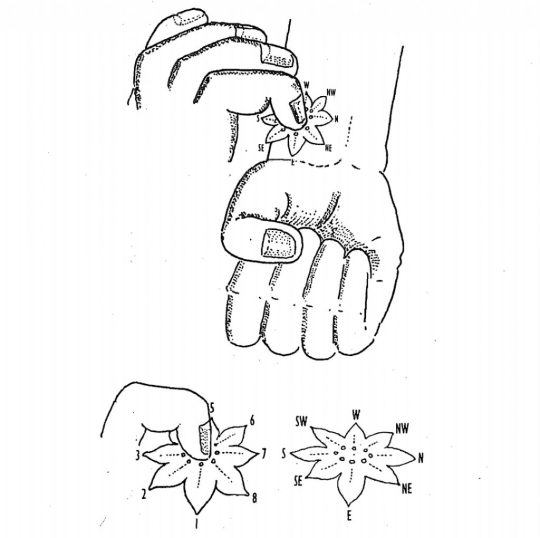
An important aspect of Indian philosophy is the theory of the five elements. When checking for manas prakruti, the person should be facing the east direction. This position will help to clarify the reading represented in the diagram. The index finger of the examiner is Air, which is vata, and is pictured as a wave. The middle finger has a spike like pitta and is represented by a triangle. Kapha is composed of the Earth and Water elements, so the ring finger is represented by a square. The lotus at the bottom of the illustration represents the finger resting on the radial artery. Under each finger checking the pulse, one can imagine that there is an eight-petaled lotus. When feeling someone’s pulse, use the diagram of this lotus to find the location of the spike. Each petal of the lotus can be numbered for convenience of understanding and the number of the direction should be noted under each finger. For example, under the index finger one might note the direction as V5. The middle finger might indicate P7.
The ring finger may reveal a reading of K. If the spike is in the east, Petal Number 1, that indicates an Indra personality, which is royal and religious. If the spike is at the position of the second petal, the southeast direction, that shows an Agni personality, which means knowledge. That person is a worshiper of knowledge. The third petal is a Yama personality, impartial. Yama is the God of Death, who loves everyone equally. He takes away the soul and puts an end to the individual’s life. These people with Yama personalities are quite impartial. They love no one, which means they love everyone, and they are also withdrawn and introspective. A spike in the fourth petal indicates a Nairutya personality. These people love to sleep and are tamasic. Indra is sattvic, Agni is rajasic, Yama is tamasic and the direction of Nairutya is also tamasic. A spike in the west, Petal Number 5, is Varuna, which is sattvic. People with a Varuna personality are loving and compassionate. Petal Number 6, which is northwest, is Vayavya, which is rajasic. The Vayavya personality is emotional with mood swings.
A spike at the seventh petal indicates Kubera, which is sattvic. People with this personality are rich in mind and blessed with long life. Petal Number 8 is Ishanya, which is also sattvic. These people are fortunate and spiritual. This classification is explained in ancient nadi texts, which we are now learning in the twentieth century. These ancient texts tried to bridge subjectivity and objectivity. Now to learn the technique, go to the deepest pulse at the seventh level. Then gently release the pressure and come to the sixth level, where the spike changes. At the seventh level the spike will be felt at the center of the lotus. With a slight release of pressure to the sixth level, the change of direction will be felt toward one of the petals of the lotus. Try to focus your attention on each finger separately. Under the vata finger find out whether the spike is at Indra, Agni, Yama, or one of the others. Take a note of the reading. Turn your attention to the pitta finger and find the direction of the spike. Then feel the kapha finger. With this information manas prakruti can be understood as a mixed prakruti of vata, pitta and kapha. The spike under each finger might be at a different petal of the lotus, helping to clarify the understanding of the individual’s personality. Don’t compare the reading with the prakruti of the subject, just feel the direction of the spike while visualizing the lotus.
To simplify, pay attention to which finger has a more prominent throbbing. Suppose the prominent throbbing is under the index finger. Then read manas prakruti under the finger with the most prominent throb, because the mind and consciousness are expressing, through that throb. Suppose the prominent throbbing is best felt under the index and middle fingers, compare which is more prominent. Under that prominent finger, meditate and visualize this eight-petaled lotus. This is a subtle perception. There is an eight-petaled lotus under each of the fingers of the examiner and one can read all three fingers, but that is too complicated initially. For beginners it is better to practice on the finger with the prominent spike, one finger at a time. Once you read your own manas prakruti, turn to a friend and try to feel his or her manas prakruti. Ideally the subject should be facing east and the reader should be facing the west direction, which will simplify the reading. The tips of the fingers, of the person being examined are always visualized as facing the east direction. However, any direction can be faced as long as the anterior aspect is seen as east and the posterior aspect as west. Keep the finger reading the pulse stationary. Don’t move it in all eight directions. This is imagination, but the greatest scientist is gifted with a positive power of imagination. Try to be a scientist and be imaginative.
Use the right hand of the person for a man and the left hand for a woman. The lotus is in the same position on both hands. Don’t become confused by the position of the subject’s thumb on the right and left hands. The orientation of the lotus is the same on both hands and does not change in its relationship to the position of the thumb. Just keep the orientation of the fingertips of the subject facing east.
Planetary Principles in the Nadi
The sixth level of the pulse can also denote planetary principles acting in the nadi. These readings may not correspond to one’s Jyotish astrological birth chart. The sixth level of the pulse indicates the status of the mental body. The modern term astral body is composed of the ancient Upanishad descriptions of the prana body and the manas body. The movement of prana becomes disturbed by the vibrations of thoughts, feelings and emotions coming from the manas body. So, the mental body can disturb the astral body and the astral body can disturb the mental body. Before pathological changes happen in the physical body, subtle changes take place in the mental and astral bodies. In other words, the mental and astral bodies play an indirect role in the immune system, affecting Agni, tejas and ojas.
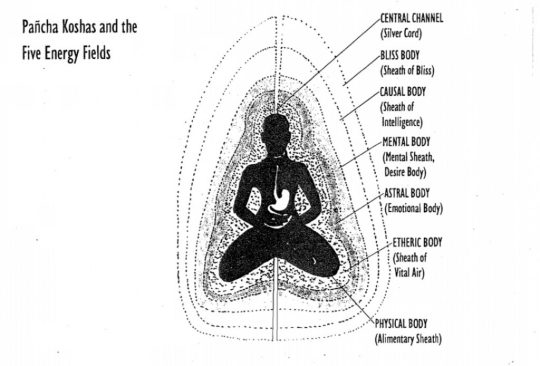
Many times, people ask what stone they should wear, on which day they should fast or which deity they should worship. The sixth level of the pulse reveals this information. Read each finger in the same way as for manas prakruti. For example, if the reading of the petal numbers denotes V2 P3 K5, V2 represents Ketu and the person should wear a cat’s eye or a pearl. Petal Number 3 on the pitta finger is Mars, so the person should wear a red coral necklace. With this combination of vata and pitta the person should wear a red coral necklace with a pearl in the center. Petal Number 5 on the kapha finger represents Jupiter and the stone to be used is a yellow sapphire. Using the correct gems facilitates healing. Life without a personal deity is without direction, leading us to a feeling of un-groundedness. When anchored with a deity, one will never feel lonely or ungrounded. One’s connection with a personal deity brings stability, direction and perfume to life.
Then the whole life becomes a celebration, not a meaningless futile game. It is difficult to have a direct relationship with Almighty God, but worship of a personal deity such as Ganesha, Vishnu, Rama, Krishna, Christ or Buddha brings communion with higher consciousness. Almighty God is experienced through the personal deity and this deity becomes a bridge to salvation and enlightenment. The choice is also guided by which doshas are active in the manas prakruti and vikruti. If vata is active, the person should wear a cat’s eye, which will calm vata. There is a bridge between dosha, planets and gemstones in manas prakruti. When one fasts on a specified day, the blessing of that particular planet is received. In Ayurveda there is a branch of astrology called astrotherapy (graha chikitsa) which addresses the influences of the planets upon the person.
For example, a person has a pitta problem and under the pitta finger the spike is in the Mars position (Petal Number 3).This high pitta is due to the affliction of Mars in the mind. Wearing a red coral necklace will absorb the Mars energy and fasting on Tuesday will calm down pitta and the Mars provoking influence. Fasting according to these principles will eliminate mental impurities or ama. Enlightenment has many doors and there ‘are many paths to realization. God never asks through which door you come, in which car you arrive or on which flight. He is just happy to see you and bless you. There are many ways to become enlightened—mantra yoga, jhana yoga, bhakti yoga, karma yoga, chanting the holy name of God, fasting, doing puja, doing worship—all these ways lead to God. The Ayurvedic culture makes life a splendid ceremony. Even death becomes a ceremony. People take the body, carry it to the cremation yard, chant mantra, burn the body to ashes and carry the ashes to the sacred river. The deceased person’s soul is happy and that soul has equal energy to that of God.

Therefore, never speak bad things about a deceased person. This is very important. A person makes his life miserable if he carries unresolved emotions about a deceased father or mother. Never ever carry unresolved anger about a deceased person. When a person has ceased to exist physically, that anger should be resolved and released. The deities related to the Sun are Rama, Gayatri Devi and Christ. Shiva is related to the Moon and Monday is a good day to worship Shiva. Mars is connected to Lord Ganesh and, when Mars is activated, Ganesh will cool down Mars energy. Mercury is related to Lord Vithala, Krishna and Vishnu, Jupiter to Lord Dattatraya, Lakshmi and also Lord Balaji. Buddhists worship Buddha. Venus, Friday, is Lakshmi, Sarasvatl, Durga and Allah. Saturday is Lord Shani and Hanuman. Hanuman is also worshipped to calm down Mars. According to Vedic philosophy, Hanuman is a living entity who is the son of Wind God and travels with the speed of the wind. He is the dedicated servant of Rama. Hanuman is full of love. He stands for bhakti and service. He protects us from evil energy, such as ghosts and spirits. Chanting the Hanuman Chalisa on Saturday and Tuesday will activate this protective energy. Rahu and Ketu are pleased by worshipping them on Saturday and Tuesday respectively. Fasting from sunrise to sunset is a good discipline, cleansing the body, mind and consciousness. For fasting take fruits or fruit juice, which are sattvic, and don’t eat any cooked grains.
In Hinduism there are 36,000 deities. The Hindus worship everything as a manifestation of God—trees, flowers, and there is even a special day for cows. They also worship the bull, which is a vehicle of Lord Shiva. They are innocent like a child and innocence is the perfume of life. Knowledge is beautiful but knowledge makes the person rigid, it makes the person logical. Logic is based upon knowledge and reasoning. On the other hand, intelligence is creative. Hence, logic has no intelligence.

Chakras in the Nadi
The word chakra means wheel and chakras are centres of energy in the body related to physical, mental and spiritual energies. If the flow of energy in any of these centres becomes blocked, stress is reflected in the physiology. The sixth level of the pulse also reveals how well each of these chakras is functioning. If a spike is present, that chakra is working under stress. A healthy chakra has no spike. Return to the same sixth level pulse to find which chakra is stressed. Reading this information is slightly different. Gently move the finger and find the location of the spike. The ring finger at the proximal curvature denotes the activity of muladhara, the first chakra, and at the distal curvature the activity of svadhisthana, the second chakra, is felt. On the middle finger one can detect manipura and anahata respectively. On the index finger one will feel visuddha and the sixth chakra, which is ajna. The central part of each finger denotes the activity of sahasrara. When a spike is present, that chakra is working under stress and the kundalini shakti is blocked there. That chakra needs cleansing work.
A healthy chakra has no spike because the kundalini energy moves smoothly. A dynamo that works perfectly creates no noise. However, the dynamo that is cracked creates a loud noise. Hence, the chakra that is working under stress creates a spike. We are ordinary people who are involved in worldly affairs and our chakras may not be open. What is the spike of an enlightened person? An enlightened person will have a gentle balanced spike at the site of sahasrara under all three fingers. The bija mantra for each chakra is given in the illustration of Chakras in the Pulse. Lam is for muladhara, vam for svadhisthana, ram for manipura, yam for anahata, ham for visuddha, sham-ksham for ajna, so-hum for sahasrara, and aum for bliss, located about the width of 10 fingers above the physical brain. This point is the junction between the auric field and cosmic consciousness and is called anuchara, the unspoken soundless sound, the sound of one hand clapping, sound without duality.

If the person mentally recites the appropriate mantra 108 times, it helps to release the blockage and open any chakra. The chakra system and chromo-therapy go together. The seven rainbow colours are red, orange, yellow, green, blue, purple, and indigo, and they are also the colours of the chakras, from muladhara to sahasrara respectively. A spike at muladhara on the proximal curvature of the ring finger may be connected to the reproductive organs— testicles, ovaries, cervix and prostate. The person may have sexual debility or low libido. If the spike is on the distal curvature of the ring finger, it is connected to the second chakra, svadhisthana—kidney, urethra, bladder and adrenals. The second chakra is also connected to the spleen and governs the water element. The third chakra is functionally connected to the stomach, pancreas, small intestine, liver and gallbladder. The fourth chakra relates to the heart and lungs and the fifth to the vocal cords, thyroid and parathyroid. The sixth is related to the third eye and the pituitary gland and the seventh to the pineal. With this understanding, now try to read your own chakra pulse and then read the condition of your friend’s chakra pulse.
The right hand in the man and the left hand in the woman should be used to understand the chakras. To find this pulse at the sixth level, gently tune your finger to locate the presence of the spike. Try to contact the throb. This information is at the same sixth level as manas prakruti and the planetary influences, but fine tuning is different. A spike at sahasrara on the kapha finger means the crown chakra has a tarpaka kapha disorder. A spike at sahasrara under the pitta finger indicates sadhaka pitta is involved. If the spike is under the index finger, prana vata is involved. An uneven spike at the sahasrara site under all three fingers means the person is mentally disturbed. But if the spikes are equally balanced at this position under all three fingers, the person is enlightened.
The Present Flow of Consciousness
Now let us shift our attention to the second level. Just a bit below the superficial pulse on the first level, the spike changes. The second level represents the present flow of consciousness. Although we refer to this present flow of consciousness as manas vikruti, it is more appropriately called the present status of the mind. Under each finger visualize the eight-petaled lotus representing the eight directions in the same manner as at the sixth level. This pulse changes approximately every 90 minutes, due to changing thought waves and feelings. It is not permanent, because it is a flow of consciousness connected to the thought wave.
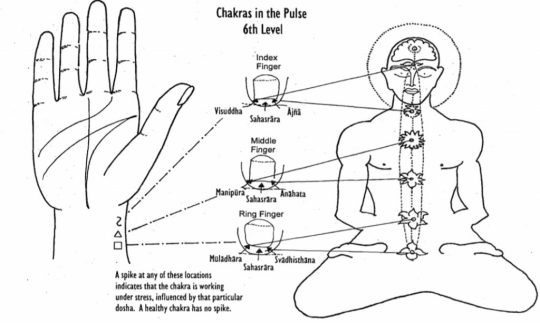
At one moment there may be a wave of sadness and depression. In the second moment one may feel happy and cheerful. A spike in the east direction (Petal Number 1) represents creative, positive thoughts. A spike in the southeast (Petal Number 2) represents judgmental thoughts, sometimes self-criticism or perfectionism which is judgmental. Pitta people are often, perfectionist kind of people which creates a lot of stress in them. A spike in the south (Petal Number 3) indicates depression and low self-esteem. The fourth direction is southwest (Petal Number 4), representing pessimistic thinking. The west direction (Petal Number 5) is attachment and emotional thinking. People are attached to status, relationships and objects. Attachment can be to anything. The northwest direction (Petal Number 6) represents a chattering mind and north (Petal Number 7) indicates thinking of money and success. Northeast (Petal Number 8) is spiritual thought. The mind is calm, quiet and serene.
This level may or may not be the same as the manas prakruti at the sixth level. For example, a person may be born with a sattvic manas prakruti but may become predominantly rajasic manas vikruti as he or she reaches adulthood. Perhaps the vata finger may indicate depression but the pitta finger may show judgmental thinking and the kapha finger vikruti but may become predominantly rajasic manas vikruti as he or she reaches adulthood. Now we will try to read the second level of the pulse. First read your own and then your friend’s pulse. Keep the fingers still. For comparison, use each finger separately.
Perhaps the vata finger may indicate depression but the pitta finger may show judgmental thinking and the kapha finger into your prana with your inhalation. However, you should exercise caution with this practice because you may receive the energies of the subject and pick up the person’s feelings and emotions. To feel someone’s pulse is an energy exchange. There are certain methods to protect oneself. Practice So-Hum meditation and watch the breath. In addition, wearing gemstones and crystals such as amethyst, rose quartz and a rudraksha mala will add protection. One can also practice the meditation of passive awareness during which there is doing without the sense of the doer. Emotions can enter through the breath. When one unconsciously breathes in, one can take in another person’s energy. Even when walking by someone on the street who is throwing out thoughts of anger and fear, these molecules, these atoms of thoughts are inhaled.

When arriving home, if the feelings of sadness come without any apparent reason, we have picked up that person’s energy. Conscious breathing and the So-Hum mantra are very important. When practicing So-Hum meditation, one does not incorporate other people’s energy. One remains alert and tranquil. There are many ways to improve the sensitivity in the fingers. Rub the fingers with certain medicated oils containing brahmi and vacha, which bring more alertness and sensitive observation. I always do So-Hum meditation when I. feel the pulse. With So-Hum, the mind is not interfering, the thoughts and feelings are not interfering and the perception of the pulse becomes clear. You can also use any guru-given authentic mantra. A mantra can neutralize the blockage and interference created by one’s own thoughts and pulsations.
Examining an individual’s pulse is meditation. Meditate, feel the pulse, focus attention on the mantra and you will feel pulse under your fingers. In this way the reading will be accurate. Practically, the sixth level of manas prakruti doesn’t change unless one becomes enlightened. When one transcends normal consciousness, that person is beyond manas prakruti, and to practice meditation is to go beyond manas prakruti. Up to this point, pulse reading has been more technical but to realize the subtleties of the pulse needs mere sensitive awareness. The concepts presented in this article are complicated and will bring up many questions in the mind of the reader. However, all these questions can be answered by the development of subjective perception.
Read the full article
17 notes
·
View notes
Text
What is the essence of Hinduism
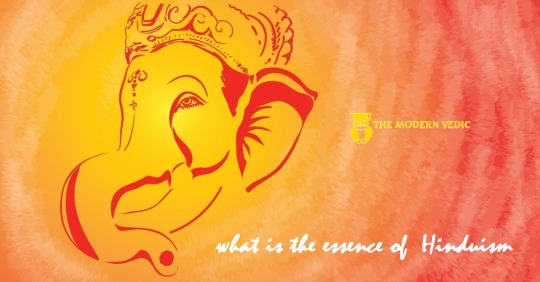
Hinduism literally speaking is the religion of Hindus. Hindu is one who is a believer in any form of Brahmanism (one of the religions of India). In his lecture, delivered at the Parliament of Religions, at Chicago in Sept. 1893 Swami Vivekananda said, "Three religions stand in the world, which have come down to us from prehistoric times, Hinduism, Zoroastrianism and Judaism. They have all received tremendous shocks, and all of them can be proven by their survival, their inner strength.
Sects after sects arose in India and unwillingly tried to shake and shatter the religion of the Vedas to its very foundation but like the waters of the seashore in a tremendous earthquake it receded only for a while, only to return in an all-absorbing flood - a thousand times more vigorous and when the tumult rush was over these sects were all sucked in, absorbed and assimilated into the immense body of the mother faith."
http://youtube.com/watch?v=hi8g2h7mvMA
Essence of true religion consists of nothing but the eternal truths and laws of the spiritual world. These principles have been discovered by the sages of ancient India. The degradation of Hindus took place because the life-giving principles of religion or Hinduism were applied in the practical life to solve social and national problems. Caste tyranny, loss of faith in their inherent powers and social neglect, reduced poor masses to mere cogs in the wheels of the exploitative machine, which was run by a few, powerful people. In reality if religion of the Vedas i.e. Hinduism was spread among the poor masses, it would awaken the dormant powers in them and they would be able to solve their own problems without any assistance.
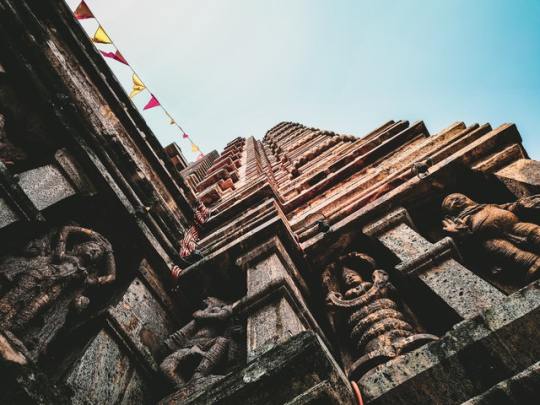
Hindus were a philosophical race, whose conflicts were intellectual conflicts. Fortunately, India then was a country where the people had no lack of wealth, food and security. Having the Himalayas in the north and ocean on three sides, the country was free from the danger of foreign invasion. Nature was also favorable in such a place, in the Ashrams and Tapovans, the Indian rishis absorbed themselves in deeper truths of life which gave birth to the Indian philosophy.
Dr. Radhakrishnan writes "The native utterances of the Vedic poets, the wondrous suggestiveness of the Upanishads, the marvelous psychological analysis of the Buddhists and the stupendous system of Shankara are quite as interesting and instinctive from the cultural point of view of the system of Plato, Aristotle, Kant and Hegel, if only we study them in true scientific frame of mind, without disrespect for the past or contempt for the alien" which is interesting and instructive from a cultural point of view
Philosophy had a great impact and importance in India especially to Hinduism from the earliest times. "Darshan" as philosophy is called, etymologically means, "Seeing". This seeing is possible by perceptual observation direct experience, inference or self-realization. Indian philosophy recognizes that truth can never be self-contradictory.
Therefore, in order to realize the distinction and relation of philosophy and religion i.e. Hinduism in the present context, we must first know what religion is. The word religion includes two Latin terms "Religio and Onis". Re-means again, ligio means to bind. Literally speaking religion binds a man to his source. Philosophers have emphasized one or the other aspect of it. Some important approaches in this connection are as follows:
Intellectual Approach: Religion is clearly a state of mind.
Moral Approach: Religion is nothing but morality touched with emotion
Axiological Approach: God cannot be called the highest value because there is no un-valued phenomenon with which God can be contrasted.

Various definitions of Hinduism as a religion.
Hinduism is a complex phenomenon in which one finds attitudes and feelings towards ultimate reality or God. From the definition of religion given by Sri Aurobindo, Hinduism appears to be highly comprehensive. To quote him "in most, essence of religion... is the search for God and finding of God. Its work is sincere giving out of the true and ultimate relation between man and God, relation of unity, relation of difference, relation of an illuminated knowledge and ecstatic love and delight, and absolute surrender and service, casting of every part of our existence of its normal status into up rush of man towards the Divine and descent of divine into man". This is true even today when we talk of Modern Hinduism.
Our age is known as the atomic age. By controlling atomic energy man has achieved things which were formerly beyond his imagination. In the form of atom bombs he has developed an instrument of destruction whose after effects can be seen years after its use. Many nations, developed or even underdeveloped, of the world are busy in piling up such destructive weapons and many other nations are trying to copy them.
This has made the thinkers of the world to worry about the future of man because an atomic war will not only lead to destruction and death but also deformities of crores of people and poisoning of the atmosphere and water to the extent of making human life practically impossible on this planet. But international peace and cooperation cannot be achieved through science alone because science is unable to do anything in this situation. This on the other hand is a moral and spiritual problem. For example, the philosophy of the Gita and the Upanishads may be found to be the most useful to a man at the present juncture. Hence it can be said that in this atomic age, science is more in need of philosophy than it has ever been.
Ancient Indian thinkers of Hinduism have suggested different paths for reaching God or Truth, which is relevant in modern times also. These are classified into three chief paths of action, knowledge and devotion. In fact, these are the phases or the three different layers of every human mind.

Here we shall take the path of action. This is just like the choice between what is right and what is wrong, the good and the evil. One has to follow the right way and give up the wrong way. Gradually the evil will be eliminated and the good will be established which will ultimately lead one to godliness/ divinity.
The question that now arises is, how to ascertain which action is good and which is evil Mahavir's advice is to walk carefully so that we do not tread over, even an ant. On the other hand, Lord Krishna advises Arjuna to fight the evil forces because no one dies, as the soul is immortal
In ancient times Sri Rama accepted and abided by all limitations and restrictions of the society, and that is why he is called "Maryada Purshotam" while Shri Krishna who disregarded all social limitations and restrictions is still called "Yogeshwara Krishna". On the one hand Sita is adored as she never even saw the face of another man except her husband Rama but on the other hand Draupadi who was the wife of five Pandavas is regarded as a virtuous lady.
Yudhisthira had staked his wife in a game of dice and yet he is called Dharam Raj. Bhishma was a witness to the disrobing of Draupadi and did nothing to avoid that incident, yet he is called an apostle of morality and righteousness. Parashurama killed his mother at the behest of his father and is yet called a great rishi. Therefore, no universal standard can be set for deciding what is good and what is evil. It deals with doing, not with being. As long as one does not know his inner self all his actions are cravings of the mind for the fulfillment of desires. That is why Indra says "in the very first instance try and realize what the Atman is so that all your doubts are answered. Socrates has said, "know thy self".
Modern vision of Hinduism warrants us to rededicate ourselves to the pursuit of knowing the Self, because we possess spiritual wealth that can end all our woes. Secondly, we must inculcate a sense of unity and identity. Self-realization is the real definition of Hinduism.
Taittiriya Upanishad declares in Tantra III-1
यतो वा इमानि भूतानि जायन्ते येन जातानि जीवन्ति ।
यं प्रयन्ति अभिसंविशान्ति तज्जिज्ञासस्व तदेव ब्रह्म ॥
"That from which all those beings come into existence, that by which they live, that into which they are finally absorbed, know that be the eternal verity - the Absolute"
Once in the Ashram of Ramana Maharshi a visitor made display of his knowledge by enumerating the various paths described by various masters along with quoting the western philosophers. He inquired "one says one thing and the other says something else, which way should I go?" Ramana Maharshi rose to leave the hall, he replied curtly "Go back the way you came".
Speaking about the intellectual persons, Shri Ramana Maharshi has said, "They have made themselves like a gramophone. What else are they, Oh Arunachala? It is the unlearned who are saved, rather those whose ego has not subsided despite their learning. It is sincerity that is required and not brilliance or understanding of theory, humility, and not mental pride".
Read the full article
2 notes
·
View notes
Text
Shaivism : Core Philosophy and Fundamentals
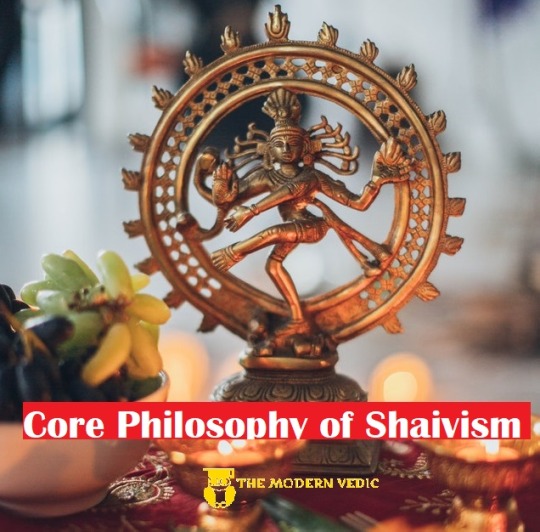
Kashmir: The Birth place of Shaivism
Kashmir, the northernmost geographical region of the Indian subcontinent is the birth place of shaivism. Kashmir was named after the great Hindu rishi Kashyap. The image of Kashmir today is a lot different from what is used to be 100 years ago. Today Kashmir has become a breeding place for radical Islamic ideologies. Kashmir was once, home to a sect of Hindus which directly worshiped the cosmos. 90% of Kashmir was inhabited by these people since 1000’s of years, until they were made to run away from their own land and settle in the other parts of India to save their lives, by radical Islamic ideologies. Today No brahmin Hindus are allowed in Kashmir as they consider Hindus as outsiders.

There are two aspects of Shaivism or Kashmir Shaivism i.e. theory and practice. The cardinal principles and fundamentals of theory are supposed to be experienced practically by means of Sadhana. Shaivism has been recognized as the highest among all the Sadhana paths that lead to self-recognition.
In this system, mind is to be withdrawn from objective activities, and directed towards the subject, which is the real self and is to be merged into it. Para-Praveshika by Acharya Khem Raj is a basic work explaining different tattvas mentioned in different Shiva Scriptures and gives us the elementary knowledge of Shaivism as well. Shaivism is about the road which consists of Shiva, shakti, Nara (Jiva) or Para, Para Para and Apara. This concise yet remarkable book is a must read for any aspirant who desires to learn and understand Shaivism.
Shiva is the absolute reality. Shakti is the divine power of Shiva, through which he conceals his nature. The manifestation of Shakti to the position of soul and world is Nara (the soul bondage, we can call it Jiva also).
Shaivism involves experiencing thirty-six principles or elements. Reality of the universal consciousness is manifested through these experiences. This school of thought believes in self-recognition, action and thought.
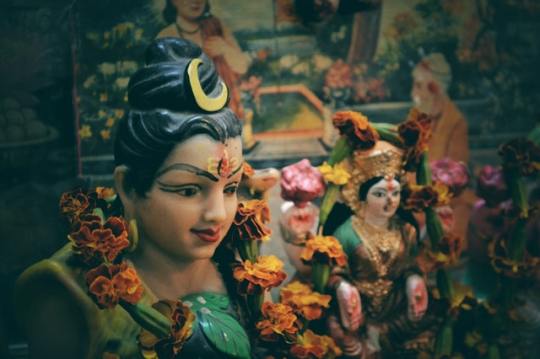
For gaining positive practical experiences, the aspirants of this system should have a moral and mental character of high order. Shaivism primarily deals with ultimate reality of the manifestation of the world process, bondage and liberation leading a devotee to realize the supreme nature of the individual soul with the eternal-principal which is nothing but Shiva alone. In other words, it is the transformation of the human consciousness into divine consciousness. Param Shiva or Shiva manifests this universe full of multiplicity and countless forms yet remains the embodiment of consciousness. His essential true nature undergoes no change.

The first movement in consciousness is called Spanda or Unmesha. From this initial throb comes the creation of the cosmos in which Shakti transforms into thirty-six tattvas, the principles or constituents from Shiva to Earth. There is no difference between Shiva and Shakti. Shiva is considered as the first principle and Shakti the second principle.
In Shaivism the universe is created, preserved and dissolved by Shiva alone. Anything done by Him cannot be unreal. Maya cannot prevail on Shiva. The Jeeva is divine or Shiva in nature but has forgotten his real nature. The experience by which he is able to recognize his real nature and bring home the truth through spiritual discipline is known as 'Paratibijna' i.e. self-recognition, a distinct school of Shaivism. The main elements of Shaivism are as under:

Acharya Khem Raj has given a rational synthesis of these thirty-six principles (concrete and real mental experiences) in his Parapraveshika and the same is briefly given as under:
Shiva: He is the universe in its entirety and beyond it. He is spirit, bliss, will, knowledge and action.
Shakti: The first flash comes out to draw out the universe. It is force, energy or the will to act. It is bliss, will, knowledge and action all combined.
Sadashiv: At this stage the feeling to emerge out develops into will to act. But more importantly, the subject object is not differentiated. Will dominates over all other shakti's.
Ishwar: At this stage the subject actually emerges out into object, 'Ahanta' (subject) the feeling of 'I' predominates over "Identa'- the feeling of 'This'. In other words, Knowledge' dominates over the feeling to emerge out.
Shod-vidya: At this stage Ahanta and Identa or T or 'This' aspect of experience is balanced. Power of Action becomes predominant.
The Five principles of unlimited subject-object experiences are:
Shiva
Ishwar
Sadashiv
Shakti
Shud-Vidya
Creative Energy or Limited Principle
Maya: This divine Shakti is responsible for differentiation. It makes us forget our true nature and binds us down to individuality. It eludes subject from the object through five cloaks or veils.
Maya's five Kanchukas- Cloaks of obscuration
Kala: It means limited power. Shiva is omnipotent but Maya has shrunk these unlimited-powers into finite form.
Vidhya: Shiva is omniscient. But Maya has put a limitation on him. So, it is limited knowledge.
Rag: Shiva is full and complete, but again, Maya has put it into bondage. So, there is attachment to sense objects.
Kaal: Time limitation. Past, Present and Future. Shiva is eternal. There is no bondage or limitations of time on Him.
Niyati: Limitation with regard to space. Shiva is omnipresent or all-pervading but here it has its own limits as Jiva.

Five limited individual experiences
Purusha: The concept of individual five cloaks of obscurations conceal the quality of the Purusha from Shiva - (the universal consciousness).
Prakriti: It consists of Gunas i.e. qualities of Sattva, Rajas and Tamas. It is different for different Purushas and is responsible for differences in the temperament of different individuals.
Buddhi is the intellect, which makes Purusha behave, doubt, reflect, think and consider.
Ahamkara is responsible for will, thought-differentiation and acts as storehouse of thoughts and feelings.
Mannah is responsible for will, thought-differentiation and storehouse of thoughts and feelings. Buddhi, Ahamkara and Mann are together called as Antahkarana.
The Five sense organs (Jnana Indrias)
Shruti
Jiva
Gran
Tvakh
Chakhshu
Five organs of action (Karam Indrias)
Vakh (Tongue (Speech))
Pani (Hand)
Pad(feet)
Payu(Urethra)
Upasth(anus)
These organs have no functions other than to receive pulsation or vibration of five elements of sense perception.
Five objects of perception (Tanmatr)
Shabad
Sparsh
Roop
Ras
Gandh
Gateways through which these are perceived are Skin, Nose, Ears, Eyes, Tongue, Sound Touch, Form, Taste and Smell. These are also called elements of sense perception.
Five gross elements (Maha Boot)
Akash (Space) Channel for force to act.
Vayu (Air) - Gaseous state which sustains life.
Agni (Fire) - Thermal motion - heat, light and life.
Jal (Liquid) - Forms life.
Prithvi (Earth) - Sustains everything.
Shaivism and Shiv Sutra
As per one of the Sutras, "Life is consciousness" (Shiv Sutra 1-1) Consciousness is all pervasive. Shiva is a wave-less ocean of consciousness. Through His play, this universe has become Grahaka - the perceiver and Grahaya - the perceived. The emergence of thirty-six Tattvas - constitutive principles, the consciousness gives rise to the universe and its activities.
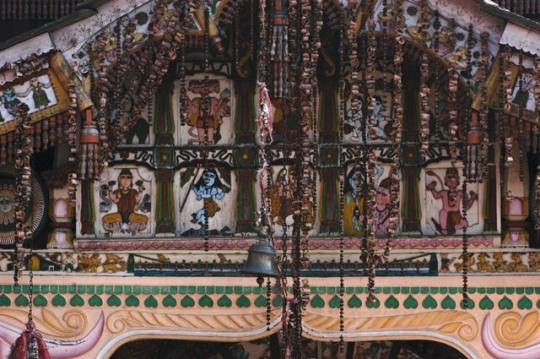
For purposes of understanding the practical aspect, the universe has been divided into three categories. These are called as Pramata, Pramana and Prameya.
Pramata, is limited individual (Jeeva) who understands the nature and activities of the universe. The universe is Prameya and its correct understanding is Pramiti. Since the universe is not different from Param-Shiva thus there are no means of separating Him from the universe, by which we can know Him. He is both the means and the end. Consciousness reveals its own nature and also gives us the knowledge of the other objects.
This is called Param Samvit. Through the independent power of this supreme 'l-consciousness' Param Shiva becomes 36 Tattvas and reveals seven experiences which are :
Shiva Chitt: Highest, The Absolute.
Mantra Maheshwar: One who has realized Sada- Shiv Tattva.
Mantreshwar: One who has realized Ishwer Tattvas.
Mantra: One in between Shud-Vidhya Tattva.
Vijnan kala: Key-experiment in between Shud-Vidya and Maya-Tattva
Pralyakal: Experience of the void.
Sakal: Limited experience dominated by Maya Tattva (worldly pleasures). Not knowing his real self.
Param Shiva or Shiva exists as the universe in its infinite powers. The powers, Shakti are:
Chit Shakti: Shiva is self - luminous and wholly independent.
Anand Shakti: Shiva has ability to experience bliss with Himself without any external cause.
Ichha Shakti: Shiva can do anything in a miraculous way without opposition and with firm resolution.
Kriya Shakti: He can create objects of various forms.
Shiva with these powers of Shakti continuously performs five actions:
Creation (Shristi) = Creation of the Universe
Sustenance (Sthiti) = Maintenance of the Creation.
Dissolution (Sanhar) = Absorption of the creation into Himself.
Concealment (Pidhan)= State in which creation remains within Him, before being remembered or re-created.
Bestowal of grace (Anugrah) = Complete merging of the creation into the Universal Consciousness.
कणास्त्वद्दीप्तीनां रविशशि कृशंनु प्रभृतयः।
परं ब्रह्म क्षुदं तव नियतं आनन्द कणिका||
शिवादि क्षिति अन्तं त्रिवलयतनोः सर्वम् उदरे।
तव आस्ते भक्तस्य स्फुरसि हदि चित्रं भगवति ||
O Goddess! Your flashes, like the sun, the moon, fire etc. and even Great Lord is of little consequence when compared to your divine Shakti and bliss. You are the embodiment of the whole universe from Shiva to Prithvi in three aspects (Knower, Knowledge and Known). In-spite of all this greatness you dwell in the hearts of your devotees.
https://www.youtube.com/watch?v=B_3I0y4DYwA
Read the full article
3 notes
·
View notes
Text
How to activate Chakras with Gayatri Mantra ?

The syllables of the gayatri mantra are said to positively affect all the chakras or energy centers in the human body. Hence, proper pronunciation and enunciation of the mantra is very important to activate chakras in your body.
Scientists have investigated the vibrations produced by the gayatri mantra and have found that when this mantra is recited with correct pronunciation, as laid down in the Vedas, the atmosphere around becomes visibly illumined. When this mantra is chanted, it is said that Brahma-prakāsha, the Divine Effulgence, will descend on you, illuminate your intellect and light your path. Also repeating shanti, thrice at the end, of the repetition will give shanti or peace to the three entities in you viz body, mind, and soul and even help in activating the chakras of your body.

The masters of Mantra Vidya know that when we speak, the words are uttered by different parts of our mouth such as, throat (larynx), tongue, teeth, lips and the root of our tongue. During speech, the nerve-fibers of the mouth, from which the sound emits, stretch different parts of our body and pressurize the corresponding glands. If a particular gland, gets diseased or dysfunctional, we start stammering when we speak those specific words. There are many large and small, visible and invisible glands in our body. Yogis know that some specific energies, are hidden in all of these glands. Different words have different impacts on different glands, because of which, the energy of these glands gets stimulated.

How this science to activate chakra works?
There are twenty-four letters in the Gayatri-Mantra which are related to twenty-four such glands located in the body which, on getting stimulated, activate and awaken the powers of righteous wisdom and enlightenment. By chanting the Gayatri Mantra, the sitar of the subtle (Sookshma) body, and the Sadhak can activate chakras in the process, tinkling twenty-four different points of our body, and creating sound waves which affect the important elements of the invisible world. It is this impact on the important elements which becomes more and more pronounced and tangible through regular chanting of the Gayatri Mantra.
The flow of sound of these twenty-four letters of the Maha Mantra is of deep significance. The experts of the science of sound, know the powers hidden in sound and the results which can be achieved by its subtle vibrations. Sound is synonymous with Brahma. It is Brahma from whom the original creative vibration is generated, which is equivalent to seven-times chanting of OM. Just as the pendulum of a clock keeps on moving by swinging to and fro, the sound waves of Om create vibrations which regulate this creation.
These vibrations lead to generation of the three main waves of Sat, Raj and Tam related to Hreem, Shreem and Kleem elements respectively. It further gets divided into branches and sub-branches which are known as Beej-Mantras. The letters, words and clauses of the Gayatri Mantra have been analysed by seer vision. The vibrations generated due to the gayatri mantra, emanate from the unified field of creative energy, and are arranged in a specific, special sequence forming a large number of inter-relationships. The Gayatri-mantra when Chanted with sincere devotion, plugs the sadhak’s soul into the supreme and inexhaustible fountain of spiritual energy. For example, Singing of the Deepak-rag with sincere devotion lights up extinguished lamps. Similarly a practitioner can light the lamps present in the body i.e the practitioner can activate Chakras by chanting the proper mantras.

It starts raining when the megh-malhar tune is sung. The warbling of cuckoo incites passion in men as well as women. Even strong iron bridges may collapse by the sound vibrations created by the in-step, coordinated and rhythmic marching of troop soldiers. This is the reason why armies are forbidden to march rhythmically, in-step, while crossing bridges. Dr. Hutchinson of America has achieved success and fame by curing several patients suffering from incurable and painful diseases, with the help of different musical sounds and vibrations. In India, Tantriks keep a Thali (large metallic plate) on a pot and play it like a drum, in a special rhythm.
They are capable of curing persons bitten by poisonous snakes and scorpions. They are also capable of healing those suffering from thyroid goitre, Vishvel (poisonous creeper), ghosts, phobia, etc. The vibrations of a specific sound spread in the ether, attract atoms of similar type and return to their origin position within a few moments, duly charged with appropriate energy which has a curative impact on the appropriate area.
This is how Mantras have miraculous effects. The chanting of Gayatri Mantra activates a network of nerves in the mouth which in turn stimulates specific glands. As soon as the glands get stimulated, a Vedic symphony is created which spreads in the ether, takes a round of the entire universe and comes back to its source with its energy augmented manifold.
The basis of hypnotism is to get the desired work done by the subject just by infusing faith in him. The Mantra of a Tantrik works miraculously on the patient only if he has deep faith in it. A Sadhak devoid of faith may utter a Tantrik Mantra hundreds of times but it will not have any effect on him. This fact applies to Gayatri Mantra as well. When the Sadhak takes up Sadhana with faith and confidence, Gayatri Mantra becomes much more effective and proves to be extra-ordinarily powerful due to the combined effect of faith and the Mantra’s own intrinsic spiritual energy. The sketch below depicts which particular letter of Gayatri is related to which part of the body.
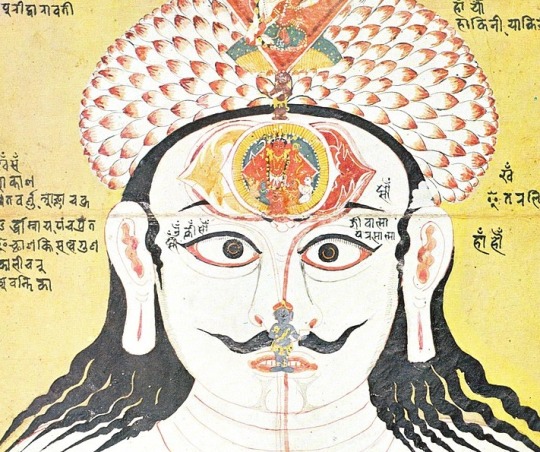
Activate chakras with Gayatri Mantra Meditation
Preferably in the morning before sunrise, sit straight with your head, neck and trunk aligned in a straight posture. Let your body and breath relax. Pay attention to the incoming and outgoing of your breaths. Continue breathing until a soft and rhythmical abdominal breathing gets established. Follow the energy centers systematically in ascending order, in the central channel, of the space behind the abdominal wall and the space in front of the spinal column
Muladhara Chakra (Root chakra): Bring your attention to the tail bone and the pubic bone in the front, i.e. the pelvic floor area of your body. Slightly contract the pelvic floor to deepen your awareness of the region. Visualize the Sun, reddish, soft and gentle as it appears at the crack of dawn. Silently recite the Gayatri Mantra.
Svadhishthana Chakra (Sacrum Chakra): In order to deepen your awareness of this Chakra, slightly contract the space between the sacrum at the back and the procreative organ in the front. Visualize the Sun moving up from the Muladhara Chakra into the Svadhishthana Chakra. Silently recite the Gayatri mantra.
Manipura Chakra (Navel Center): In order to deepen the awareness of this Chakra region focus your attention on the space between your navel and the lumbar region. Exhaling while gently pulling in the navel can sharpen your concentration on the Manipura region. Visualize the sun, as it would shine an hour or two later after the sunrise. Visualize the sun moving up from the Svadhishthana Chakra into the Manipura Chakra. Silently recite the Gayatri mantra. This will activate the chakra of the Sun.
Anahata Chakra (Heart Center): In order to deepen your awareness, concentrate your attention on the space between the heart region in the front and the spinal discs between your shoulder blades. Visualize large bright Sun rising from the Manipura Chakra through the central channel to the center of the heart area. Silently recite the Gayatri mantra.
Vishuddha Chakra (Throat Chakra): Bring your attention to the space between the pit of your throat and the spinal column right behind.it. Visualize the Sun moving up from the Anahata Chakra up to the Vishuddha Chakra. Silently recite the Gayatri mantra.
Talu Chakra/ Lalana Chakra (Uvula/soft palate center): Deepen your awareness on the space between the uvula/soft palate in the front and your neck discs in the posterior. Visualize the Sun moving up from the Vishuddha Chakra through the central channel up to the uvula/soft palate. Silently recite Gayatri mantra.
Ajnya Chakra (The Eye-Brow Center): Deepen your awareness on the space from behind the eye-brow center to the Occiput area/cervical discs in your back. Visualize the Sun moving up from the Talu Chakra through the central channel up to the Ajnya Chakra. Silently recite Gayatri mantra. This will activate the chakra of the third eye.
Sahasrara Chakra (The Crown Chakra): Deepen your awareness of and around the crown of your head. Visualize the Sun moving up through the central channel from Ajnya Chakra to Sahasrara Chakra. Visualize the brilliant sun with its rays spreading out like thousand petals of lotus into the space beyond. Silently recite the Gayatri mantra. This will activate the chakra which connects us with the cosmos.

You may end your Gayatri mantra Chakra practice at this point. You may do as many rounds as you like depending upon the time you have.
How to Open Third Eye with Gayatri Mantra Meditation
Below are the step-by-step instructions on how to do this meditation in order to open the Third Eye Chakra:
Sit in any cross legged posture you like. You can also do this meditation on a chair.
Elongate your spine and tuck your chin in slightly (like a soldier at attention). Bring your hands in Gyan mudra. Then, rest your wrists gently on your knees, with your palms pointing in the upward direction.
Close your eyes and turn them upwards such that you looking through the center of your forehead. This is Shambhavi mudra. Do this mudra for as long as it is comfortable.Don't Over-do it. Release your eyes whenever necessary and continue with the meditation, reapplying it when ready.
Start chanting the Gayatri Mantra mentally. Visualize the vibrations emanating out from your Third Eye, Chakra Point.
Continue to chant the mantra silently. You can do this meditation for as long as you like. Start with 3 minutes and build up with time and regular practice.

Activate Chakras with the Gayatri Mantra Kriya
The following is a long version of the Gayatri-Mantra, which helps us activate chakras and the lokhas (heavens) in our awareness, which leads us to enlightenment. It may be practiced with or without the kriyas (actions). Kriyas are said to connect us with our atman (soul) and activate chakras. The kriyas should be practiced with the right hand only. Open your hand with the palm facing in the upward direction. When using the kriyas, it is recommended that you repeat the mantra three times and then continue repeating either the long or short version of the Gayatri mantra at least ten more times without the kriyas.

https://www.youtube.com/watch?v=SarlTxrAbIY
Read the full article
#beej_mantras#brahma#brahma_prakasha#chakra#chakras#enlightenment#gayatri#gayatri_mantra#mantra_vidya#meditation#yogis
15 notes
·
View notes
Text
Yoga Asanas for Coronavirus
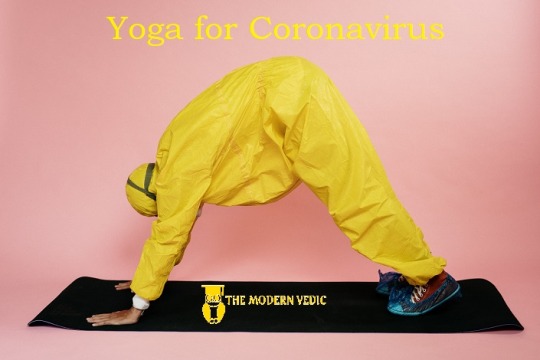
The rise of Coronavirus has put the immune system of the whole world to test. We have learned now that precaution is indeed better than cure. Coronavirus does not have any cure yet so the best way to dodge it, is to boost your immune system. In yogic philosophy Viruses are mentioned to be everywhere. It is just that we cannot see them and also we can never get rid of them. Viruses in Ayurveda are called “bhoota” which literally means ghosts. They only defense against viruses is your immune system because eventually 80% of the population is going to get it. You might have heard that it is more dangerous for old people but that’s not true. It completely depends on your immune system. A lot of people aged more than 80 years have recovered from Coronavirus cases (COVID-19). To prepare your immunity you have time until you don’t get this virus. Rishi Patanjali blessed us with the following pranayama to enhance our immune systems.
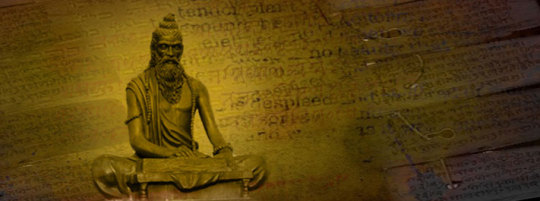
Once upon a time, long ago, all the Munis and Rishis approached Lord Vishnu to tell him that even though He had given them the means to cure illnesses through Ayurveda, people still fell ill. They also wanted to know what to do when people got sick. Vishnu was lying on the bed of snakes — the serpent Adishésha with a 1,000 heads. When the Rishis approached Him, He gave them Adishésha (the symbol of awareness), who took birth in the world as Maharishi Patanjali.
Practice these yoga asanas to boost your immunity against Coronavirus:
Bhramari Pranayama (The Pranic Humming Control)

Sit in a comfortable meditative posture. The spinal cord should be erect and the head straight. Close your eyes and relax the whole body.
Keep the mouth closed throughout the practice.
Inhale deeply through both nostrils. Retain the breath inside and perform Jalandhara and/or Mula Bandha.

After about 4 seconds release the bandhas and plug both ears with the index fingers. Keeping the mouth closed, separate the teeth and slowly exhale, producing a long continuous humming sound like a bee.
The exhalation should be slow and steady.
Feel the sound vibrations in the brain and be conscious of the sound only.
This is round one. Start with 5 rounds and slowly increase the number.
Precautions: Do not practice this pose in the supine position. Do not strain the lungs in any way.
This pose is good for your body in many ways. Some of its benefits include :
Relieves cerebral tension
Removes anger, anxiety and frustration
Reduces blood pressure.
Eliminates throat ailments
Strengthens and improves the voice.
It also creates an awareness of nada (psychic sound).
A healthy breathing pattern lowers your risk of getting affected by coronavirus.
Bhastrika Pranayama (The Bellows Breath)
Sit in any comfortable meditative asana. Hold the head and spine erect. Close the eyes and relax.
Stage 1
Place the left hand on the left knee and the index and middle fingers of the right hand on the forehead. Put the thumb beside the right nostril and the ring finger beside the left nostril. Close the right nostril by pressing the thumb against the side of the nostril.
Breathe rapidly through the left nostril 20 times, expanding and contracting the abdomen rhythmically. Then take a deep breath. Close both nostrils by pressing both sides of the nose with the thumb and ring finger, and perform the jalandhara and/or mula bandha. Hold the breath for a comfortable period of time, then release the bandhas and exhale.
Close the left nostril with the ring finger. Breathe rapidly through the right nostril 20 times with rhythmic expansions and contractions of the abdominal muscles.
Then inhale deeply, close both nostrils and perform jalandhara and/or moola bandha. Hold your breath for some time and then slowly exhale.
This is the first round. Practice 3 rounds.
Then proceed to stage 2.

Stage 2
Sit in the same position, hands on the knees.
Breathe rapidly 20 times through both nostrils.
Then inhale deeply, hold the breath and perform jalandhara and/or moola bandha. After a comfortable period release the bandhas and breathe out.
This is the first round. Practice 3 rounds.
This is the end of the complete practice of bhastrika.
Advanced practitioners may increase the number of inhalation and exhalation up to 50 and the number of rounds may also be increased up to 5 for each stage.
Precautions: A feeling of faintness or perspiration indicates that the practice is being performed incorrectly. Avoid violent respiration, facial contortions and excessive shaking of the body. If any of the above symptoms are experienced, then advice of a yoga teacher should be sought. Relax during the practice and rest after each round. Bhastrika should be done slowly for the first few weeks. Increase the speed of respiration gradually as the lungs become stronger.
Limitations: Bhastrika is not for people with high blood pressure, vertigo or any heart ailment. Beginners should practice cautiously and with expert guidance.
Benefits: This is a wonderful method to purify the lungs of unwanted gases and germs. It is excellent for asthma, tuberculosis, pleurisy, etc. It eliminates inflammation of the throat as well as any accumulation of phlegm. It increases the appetite by fanning the gastric fire. This asana also induces peace and tranquility of mind. Symptoms of Coronavirus like Dry Cough,Sore Throat and Difficulty in Breathing can be avoided by practicing the Bhastrika Pranayama on a daily basis.
Note: In this technique the lungs are used like a blacksmith's bellows.
Kapalbhati Pranayama (Frontal Brain Cleansing)

Sit in any comfortable meditative pose.
Close the eyes and relax.
Perform 60 to 100 rapid respirations.
Unlike bhastrika, the inhalation should be spontaneous with the emphasis on exhalation.
Then exhale deeply and perform Jalandhara, moola and uddiyana bandhas simultaneously.
Focus on the void in the region of the eyebrow center, feeling the all-pervading emptiness and calmness.
Release the bandhas, inhale slowly and relax.
This is the first round. Practice 5 Rounds.
Duration: Advanced practitioners should extend the number of rounds to 10 or more. The benefits of this Pranayama are increased if the breath retention is long. However, do not hold your breath for a long time. Increase the period of retention slowly over a period of time.
Sequence: Practice immediately before meditation.
Precautions: Do not hold your breath for an excessively long duration. Other precautions are same as mentioned for bhastrika.
Benefits: This process purifies the frontal region of the brain. Thoughts and visions are automatically stopped, allowing the mind to rest and become revitalized. It is an thrombosis. Difficulty in breathing is considered to be the most significant symptom of coronavirus. One who practices Kapalbhati Pranayama on a daily basis, will never experience breathing problems in his life.
Note: This is a good preparation technique for meditation. It is also one of the six shatkarmas used in hatha yoga.
Surya Bheda Pranayama (The Vitality Stimulating Technique)
Sit in any comfortable meditative pose. Make the spine and head erect and place your hands on the knees.
Close the eyes and relax the whole body.
Raise the right hand, placing the middle and index fingers on the forehead and the thumb and ring finger gently on each side of the nose.
Close the left nostril with the ring finger. Inhale deeply through the right nostril.
Close both nostrils, retain the breath and perform jalandhara and moola bandha.
Maintain for as long as is comfortably possible.
Release moola bandha then jalandhara bandha.
Exhale through the left nostril.
This is the first round. Repeat the same process.
Duration: Perform up to 10 rounds. Try to slowly increase the length of retention over a few weeks.
Precautions: Do not practice before or immediately after meals, because the body needs the energy for digestion. This Pranayama should be learned cautiously under expert guidance.
Benefits: This pranayama activates pingala nadi and therefore gives the practitioner dynamism to perform physical activities more efficiently.

The Great Surya Namaskara
This is not just one asana but is comprised of 12 different asanas. If you manage to complete the 12 asanas or yoga poses of this yoga sequence, it is equivalent to you having done 288 powerful yoga poses thus improving your immunity more than any yoga asana there is. Everyone knows surya namaskara is the ultimate practice to boost metabolism and burn fat.
Read the full article
#ayurveda#bandhas#bhastrika_pranayama#bhramari_pranayama#coronavirus#covid_19#immune_system#immunity#jalandhara_bandha#kapalbhati_pranayama#mula_bandha#patanjali#pranayam#surya_bheda_pranayama#yoga
3 notes
·
View notes
Text
Surya Namaskar
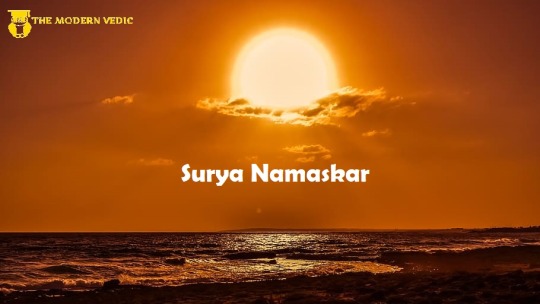
This dynamic exercise is not traditionally regarded as part of yoga practices but it is a good method of loosening up all the joints and muscles in the body, along with massaging all the internal organs. It is an excellent exercise to do in the morning after taking a bath and before practicing any other yogic techniques or asanas . If one feels tired at any time of the day, the Surya Namaskar will restore all your lost vitality, both physical and mental.
General Benefits of the Surya Namaskar
With the description of each Position a few benefits are given which can be directly attributed to that particular stage. However, Surya Namaskar gives an almost uncountable number of other benefits, which cannot be attributed to any one Position but are the result of the whole practice.
Surya Namaskar has a very powerful influence on all the systems of the body. Endocrine, circulatory, respiratory, digestive, etc. and helps in bringing them into balance with each other. Many diseases are caused when one or more of these systems are out of balance with the other systems. Surya Namaskara brings all of them into equilibrium, and thus helps in remedying many ailments that often trouble humanity.
During the practice of Surya Namaskar all the major muscles of our body are involved in a proper way. Daily practice of this exercise keeps the whole body healthy and removes excess fat. It revitalizes the body and mind along with improving the thinking power of a person.

In the Surya Namaskar All the abdominal organs are alternately stretched and compressed. The alternate stretching and compression of the abdominal organs while performing the Surya Namaskar strengthens the digestive system. This ensures that the organs function correctly. If they do not work efficiently at present, it encourages them to do so. These positions benefit those suffering from constipation, dyspepsia or indigestion.

Many people do not breathe properly. Synchronization of the breath with the physical movement during Surya Namaskar ensures that the practitioner, at least for a few minutes daily, breathes deeply and rhythmically as he should. This removes stagnant, germ-filled air from the lungs and replaces it with healthy, oxygen enriched air. Increased mental clarity is brought about by the influx of fresh, oxidized blood to the brain.
Perspiration is a vital function since it is one of the body's methods of eliminating impurities. If people do not get enough physical exercise to work up a sweat, these impurities remain inside the body and cause or aggravate disease, or at the very least, skin problems. Surya Namaskar rectifies this and gives a radiant complexion to those plagued with boils and pimples.
Many people in this modern world suffer from nervous system problems. There is no better way to remove nervous tension, stress and anxiety than by regularly doing Surya Namaskar. The movements gently massage the nervous connections throughout the whole body, allowing them to relax and become revitalized.
To summarize, Surya Namaskara is the ideal exercise to bestow good health, and who does not want good health? Surya Namaskar is recommended for all people, fit or unfit, young or old big or small, male or female.
The 12 Positions of Surya Namaskar
The Surya Namaskar is made up of 12 Positions, each of which corresponds to one of the 12 signs of the zodiac. One complete round of Surya Namaskar consists of these 12 Positions performed in succession twice. Associated with each of the 12 Positions is a mantra, which for optimum benefit should be repeated verbally or mentally.
Position I : Pranamasana (The Prayer Pose)

Stand erect with the feet together.
Place the palms together in front of the chest.
Relax the whole body.
Breath: Normal.
Concentration: On Anahata Chakra.
Mantra: Om Mitraya Namaha (Salutations to the friend of all)
Benefits: Establishes a state of concentration and calmness in the body thus preparing yur mind and body for the exercises to be done.
Position 2 : Hasta uttanasana (The Raised Arms Pose)

Raise both arms above the head.
Keep the arms separated by one shoulder width.
Bend the head and the upper trunk of your body in backward direction.
Breath: Inhale while raising the arms.
Concentration: On Vishuddhi Chakra.
Mantra: Om Ravaye Namaha (Salutations to the shining one)
Benefits: Stretches the abdominal viscera, removing excess fat and also helps in improving digestion. Exercises the arm and shoulder muscles, tones the spinal nerves and opens all the lung compartments.
Position 3 : Padahastasana (The Hand to Foot Pose)
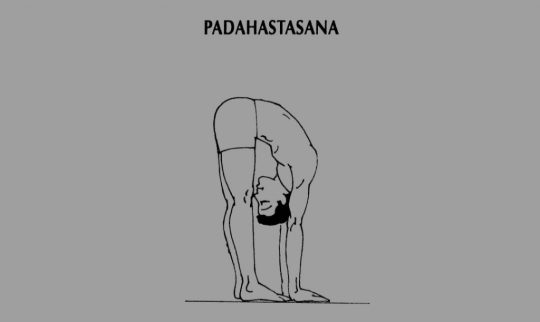
Bend forward until the fingers or hands touch the ground on either side of the feet, or in front of the feet.
Try to touch the knees with the forehead.
Do not strain.
Keep the legs straight.
Breath: Exhale as you bend forward.Try to contract the abdomen in the final Position to expel the maximum amount of air.
Concentration: On Swadhisthana Chakra.
Mantra: Om Suryāya Namaha (Salutations to he who induces activity)
Benefits: Useful in eliminating or preventing stomach or abdominal ailments. Reduces surplus fat in the abdominal region, improves digestion and helps to relieve constipation. Improves blood circulation, makes the spine supple and tones the spinal nerves.
Position 4 : Ashwa Sanchalanasana (The Equestrian Pose)
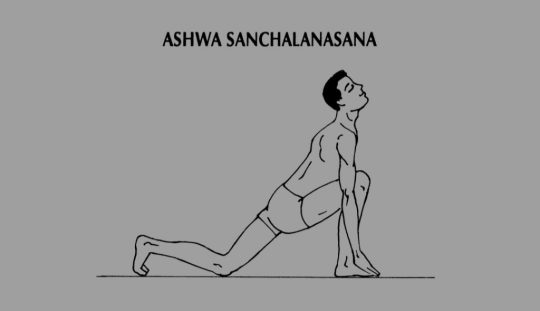
Stretch the right leg in the backward direction, as far as possible.
At the same time bend the left knee but keep the left foot in the same Position. The arms should remain straight and in the same Position.
In the final Position, the weight of the body should be supported on the two hands, the left foot, the right knee and the toes of the right foot. The head should be tilted in the backward direction, the back arched and the gaze should be directed in the upward direction.
Breath: Inhale while stretching the right leg backward.
Concentration: On Ajna Chakra.
Mantra: Om Bhãnave Namaha (Salutations to he who illumines)
Benefits: Massages the abdominal organs and improves their functioning. The muscles of the legs are strengthened. Nervous balance is attained.
Position 5 : Parvatasana (The Mountain Pose)

Straighten the left leg and place the left foot besides the right foot.
Raise the buttocks in the air and lower the head so that it lies between the two arms. The body should form two sides of a triangle.
The legs and arms should be straight in the final Position.
Try to keep the heels in contact with the ground in this pose.
Breath: Exhale as you straighten the left leg and bend the trunk.
Concentration: On Vishuddhi Chakra.
Mantra: Om Khagāya Namaha (Salutations to he who moves quickly in the sky)
Benefits: Strengthens the nerves and muscles in the arms and legs. Bends the spine in the opposite direction to the previous pose and so further helps to make it supple. Tones the spinal nerves and supplies them with a fresh flow of blood.
Position 6 : Ashtanga namaskara (The Salute with 8 Limbs)

Lower the body to the ground so that in the final Position only the toes of both feet, the two knees, the chest, the hands and the chin touch the ground.
The hips and abdomen should be raised slightly off the ground.
Breath: Hold your breath. No respiration.
Concentration: On Manipura Chakra.
Mantra: Om pushne namaha (Salutations to the giver of strength)
Benefits: Strengthens the leg and arm muscles. Develops the chest.
Position 7 : Bhujangasana (The Cobra Pose)
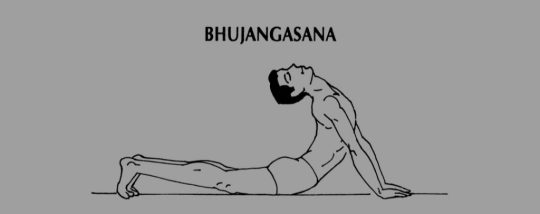
Raise the body from the waist by straightening the arms.
Bend the head in the backward direction.
This stage is the final Position of bhujangasana.
Breath: Inhale while raising the body and arching the back.
Concentration: On Swadhisthana Chakra.
Mantra: Om Hiranya Garbhāya Namaha (Salutations to the Golden Cosmic Self)
Benefits: The abdomen is compressed, helping to squeeze stagnant blood from the abdominal organs and enabling the flow of fresh blood. This pose is very useful for all stomach ailments, including indigestion and constipation. This pose also helps in Arching the back along with exercising the spine, making the muscles supple and revitalizing the most important spinal nerves.
Position 8 : Parvatasana (the Mountain Pose)

This stage is a repeat of Position 5.
From the arched back Position assume the mountain pose as described in Position 5.
Breath: Exhale as you raise the buttocks.
Concentration: On Vishuddhi Vhakra.
Mantra: Om Marichaye Namaha (Salutations to the Lord of the Dawn)
Position 9 : Ashwa sanchalanasana (the Equestrian Pose)

This stage is the same as Position 4.
Bend the left leg and bring the left foot forward so that it lies near the hands.
Simultaneously lower the right knee so that it touches the floor.
Breath: Inhale while assuming the pose.
Concentration: On Ajna Chakra.
Mantra: Om Adityaya Namaha (Salutations to the son of Aditi)
Note : Aditi is one of the names of the infinite cosmic mother.
Position 10 : Padahastasana (The Hand to Foot Pose)

This Position is a repeat of Position 3.
Place the right foot next to the left foot.
Straighten both legs and try to bring the forehead as close to the knees as possible.
Do not strain if you are unable to touch the knees, but do not bend the legs.
Breath: Exhale while performing the movement.
Concentration:On Swadhisthana Chakra.
Mantra: Om Savitre Namaha (Salutations to the benevolent mother)
Position 11 : Hasta uttanasana (The Raised Arms Pose)

This stage is a repeat of Position 2.
Straighten the whole body and raise the arms above the head.
Keep the arms separated by one shoulder's width.
Bend the head and arms in the backward direction slightly.
Breath: Inhale as you straighten the body.
Concentration: On Vishuddhi Chakra.
Mantra: Om Arkaya Namaha (Salutations to he who is fit to be praised)
Position 12 : Pranamasana (The Prayer Pose)

This is the final pose and is the same as Position 1.
Bring the hands in front of the chest and place both the palms together.
Relax the whole body.
Breath: Exhale as you assume the final pose.
Concentration: On Anahata Chakra.
Mantra: Om Bhāskaraya Namaha (Salutations to he who leads to enlightenment)
Positions 13-24: Positions 1 to 12 constitute half a round of Surya Namaskar. For the second half, Positions 1 to 12 are repeated but with a few minor changes:
a) In stage 4, instead of stretching the right foot backward, stretch the left foot back in the same way.
b) In Position 9, bend the right leg and bring the right foot near the hands.
Bija mantras: As an alternative to the twelve names of the sun, there is a series of bija mantras or seed syllables. Bija mantras do not have any literal meaning but set up powerful vibrations of energy within the mind and body. The bija mantras are six in number, and are repeated consecutively in the following order, four times during a complete round of Surya Namaskar.
Om Hrām
Om Hrim
Om Hroom
Om Hraim
Om Hraum
Om Hrah
When Surya Namaskar is practiced, too fast to repeat the sun mantras, then the bija mantras are sufficient.
Duration: For spiritual benefits do 3 to 12 rounds slowly on a daily basis. For physical benefits do 3 to 12 rounds more quickly. Beginners should not do a large number of rounds. They should start with 2 or 3 and add one more round on each successive day. Advanced students can practice a large number of rounds if they wish.
Sequence: Surya Namaskara is ideally practiced before the other asanas. This loosens the whole body and removes sleepiness. After completing Surya Namaskar the practitioner is advised to do shavasana for a few minutes. This will allow the heartbeat and respiration to return to normal rate, and relax all the muscles in the body.
Precautions: The practice of Surya Namaskara should be immediately discontinued if a fever develops due to excess toxins in the body. These toxins should be eliminated over a period of time by practicing other asanas. When the toxins have been removed, Surya Namaskar can again be commended. The practitioner should do rounds that he can comfortably perform without excessive physical fatigue.
Limitations: There are no age limits regarding the practice of Surya Namaskara. Both the old and the young can perform it. Ladies, however, should not do this practice after the fourth month of pregnancy.
Read the full article
#asanas#ashtanga_namaskara#ashwa_sanchalanasana#bhujangasana#hasta_uttanasana#padahastasana#parvatasana#pranamasana#surya_namaskar#yoga
18 notes
·
View notes
Text
How to sanitize your home naturally ?

The saying modern problems require modern solutions might be true but the need of sanitizing your home is not new. It is just that suddenly the COVID-19 pandemic has made us realize the importance of cleanliness and sanitization. One might consider rinsing his home with harmful chemical disinfectants, but in reality it does more harm than good. So, what is the right way to sanitize your home?

Sanitizing the environment is something that has been an important practice in the ancient Vedic civilization. In the past, every public gathering was initiated, only after doing certain rituals to sanitize and purify, the environment and the actual void of space.
In Ayurveda viruses and bacteria are called “bhoota” which also means ghost because ghosts live in the microcosm and are not visible to the naked eye. The process of sanitizing is called bhoot shudhdhi. Here shudhdhi means “to purify”. To Sanitize your home and kill these kinds of harmful parasites, there are certain rituals which can be performed. Let us discuss about the science of these rituals and how we can all incorporate them in our
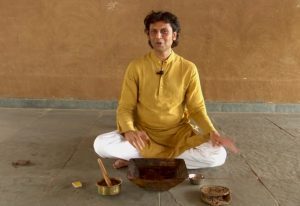
day to day lives.
Let us start with the basics. In Ayurveda fire is used to dissolve elements into the atmosphere. For example if we take chilli and put it in fire everyone present in the room will feel its effect. The pungent elements of chilli will dissolve slowly into the atmosphere. In such a scenario, the atmosphere around you, depends on the kind of element that you put into the Fire. That is the reason why one should always put sattvic (pure) elements into the fire. This concept like other concepts in Hinduism transcends other

dimensions also. For example, digestive fire is also considered a type of fire, that is why we should only put pure elements into our stomach so that our body is made up of pure elements only. If we put junk in our food our body will be polluted just like the environment. To sum it all, we should only put pure elements into the divine fire of “Yagya” and into the divine digestive fire of our stomach.
In recent years many Western scientists have done research on ancient Indian technique of Yagya. Let us focus on the scientific aspect of the practice that can be used to sanitize your home and not just on the spiritual aspect. What is Yagya ? Yagya is an ancient ritual in which we put fire in in a specific container and we feed the Fire certain herbs and then chant certain mantras. The fuel that is chosen for this fire has to be chosen properly. It is specifically mentioned in the Ayurveda, what fuel is to be used for a Yagya and what Herbs are to be put, once the fire is Lit. Yagyas can have different time spans, depending on the need and severity of the purification. There are Yagyas which can be performed in 10 minutes and there are Yagyas which take days to perform.
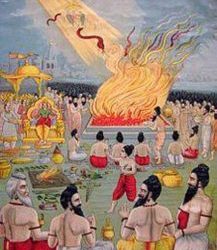
Yagya is the scientific process of sublimation and transformation of healthy constituents of plants and herbal medicines, into vapor and its expansion and dissipation in the surrounding atmosphere. It also helps in maintaining the balance of oxygen, carbon-di-oxide and other gases, along with reducing the harmful growth of poisonous, ozone layer-depleting gases and radiations into the surroundings. The term Yagya is often used for every process (e.g. cycles of Nature) and philosophy, which generates healthy and essential substances with beneficial effects and goodwill into the atmosphere. This is why Yagya has been termed as the nucleus of all the natural cycles. It is amazing to note that the Ozone Layer has also been mentioned in the Vedas. Several hymns of Rig Veda and Atharva Veda, mention that the earth is surrounded by a membrane, which is very thick. The term used for Ozone layer is 'mahat ulba'. Mahat in Sanskrit means very big and ulba is the membrane, which covers the embryo inside the uterus. In Atharva Veda the color of this layer has been called golden i.e. 'hiranyaya'. Comparing the Ozone layer to a membrane covering the embryo, it is clear that the function of this layer is the protection of earth. Disturbing this layer is equivalent to disturbing the membrane that covers the embryo inside a uterus.
The chemical-X to Sanitize Homes, Cow Ghee
Generally, Yagya mango bark is used as a fuel for the fire. But the Yagya we are going to focus on, is the “Agnihotra Yagya” which is used to Sanitize your home. For this the fuel used is cow dung cakes. I must assume that when I say cow, readers understand what I mean. By cow I mean the cow that has a a hump on its back. The cow which does not have hump i.e the hump-less cow is technically not a cow, it is a western Hybrid. Thus the Western species of a cow cannot be considered for thus Yagya. Why is this hump important? The hump of an Indian cow is its Surya nadi. Generally only humans are believed to have this nadi in their body, but cow is the only animal to have this nadi.

This is the reason why a Cow’s milk is considered to be as good as a mother’s milk in India. Along with cow dung cakes you will need cow ghee. It is important to know the difference between butter oil and ghee. The basic difference is that ghee is made from curd and butter oil is made from the cream that we get from milk.

Many people think that butter oil and ghee are same things but you should know that butter oil has a lot of harmful effects on the body while ghee, which is made from cow milk (A2 milk) does not harm the body in anyway. People with cholesterol problem can eat cow ghee in any quantity they want, but will never have any problem. But they cannot have butter oil as it can lead to serious health problems.

The next thing you need is rice grains. You will only need a handful of them. The container in which the Yagya has to be performed is made with many technicalities. Just like any scientific process we should consider the rituals as a scientific process. Every step we take in these rituals are scientifically designed and have a deep meaning behind them. We should not perform them only for the sake of performing them, but should actually do it with complete dedication. Each and every step should be taken consciously. The shape of the container depends on the type of the task we want to perform in the Yagya. The metal of the container matters as well. In agnihotra yagya a container made from copper is used. Modern view of science has confirmed that copper is a good repellent of bacteria and viruses. Mind you copper is being used in this kind of Yagya since time immemorial.
The next important thing to consider for performing this Yagya to sanitize your home is the timing of the Yagya. The Yagya should only be performed during the time of sunrise or sunset. The time should be very precise. There is a scientist from Germany who has done 40 years of research on Yagyas. He has designed a software 'Air' which will give you the timings of sunset and sunrise, of the whole year. The timing has to be very precise for performing this Yagya. Why is the time of sunrise or sunset so important? At sunset and sunrise there is a surge in the magnetic field of the earth, thus making it an auspicious time to perform this yagya. One important point to note here is that Yagya not only purifies the environment but also purifies the space of that area. When we say environment it means, the surrounding air and land. But when we say that it also purifiers the space of that area, we mean that it will also purify the Aura of that point of space in the entire universe. The technique of Yagya transcends multiple dimensions not only the physical one but the non-physical one as well. This Yagya to sanitize your home is only the tip of the Iceberg there are hundreds of types of Yagyas for attaining different types of goals.
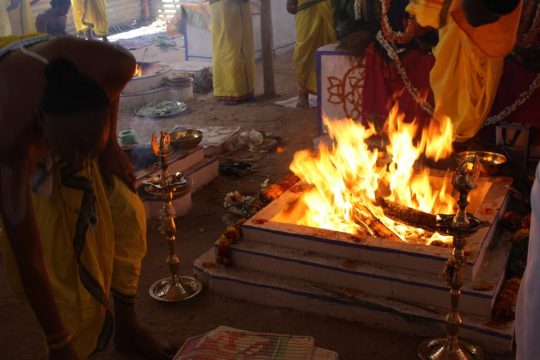
Now let’s come to the scientific aspect of this ritual and leave the metaphysical aspects. You must be thinking, that how can burning a few cow dung cakes with ghee purify environment. As discussed in the beginning, everything that we burn in fire mixes in the atmosphere as nano particles. Ghee is considered to be the purest substance in Vedic science.
Read the full article
4 notes
·
View notes
Photo
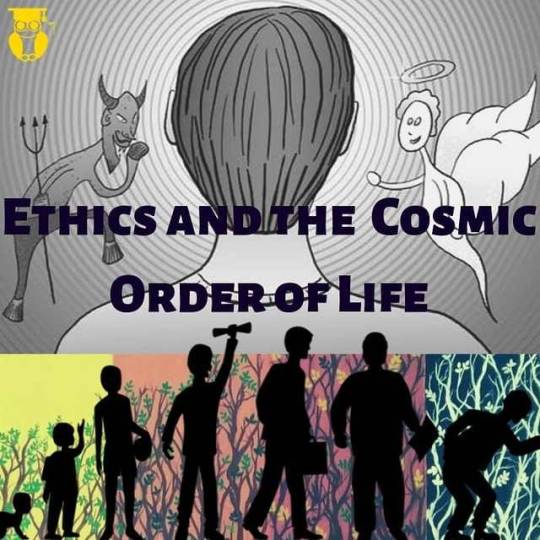
The terms ethics and morality are closely related. Ethics seeks to resolve questions of human morality by defining concepts such as good and evil, right and wrong, virtue and vice, justice and crime. The concept of cosmic order of life gives rise to the idea of Dharma in Indian tradition. In Hinduism, dharma signifies behaviors that are considered to be in accord with Rta, the order that makes life and universe possible, and includes duties, rights, laws, conduct, virtues and "the right way of living". In Buddhism, dharma means "cosmic law and order", and is also applied to the teachings of Buddha. In Buddhist philosophy, dhamma/dharma is also the term for "phenomena". Dharma in Jainism refers to the teachings of tirthankara (Jina) and the body of the doctrine pertaining to the purification and moral transformation of human beings. For Sikhs, the word dharm means the path of righteousness and proper religious practice. The word dharma was already in use in the historical Vedic religion, and its meaning and conceptual scope has evolved over several millennia. #themodernvedic #ethics #cosmic #cosmic_order #life #humanity #human_beings #moral_philosophy #moral_duty #obligation #righteousness #wrongfulness #social #spiritual #moral_code #conduct #tradition #rigveda #dharmashaastra #dharma #ashrama #purusartha #brahmacharya #grihastha #vanaprastha #sannyasa #dharma #artha #kama #moksha (at House of Ethics) https://www.instagram.com/p/B3ISNMjhHjl/?igshid=m8iunuqncj9p
#themodernvedic#ethics#cosmic#cosmic_order#life#humanity#human_beings#moral_philosophy#moral_duty#obligation#righteousness#wrongfulness#social#spiritual#moral_code#conduct#tradition#rigveda#dharmashaastra#dharma#ashrama#purusartha#brahmacharya#grihastha#vanaprastha#sannyasa#artha#kama#moksha
0 notes
Text
Ethics and the Cosmic Order of Life
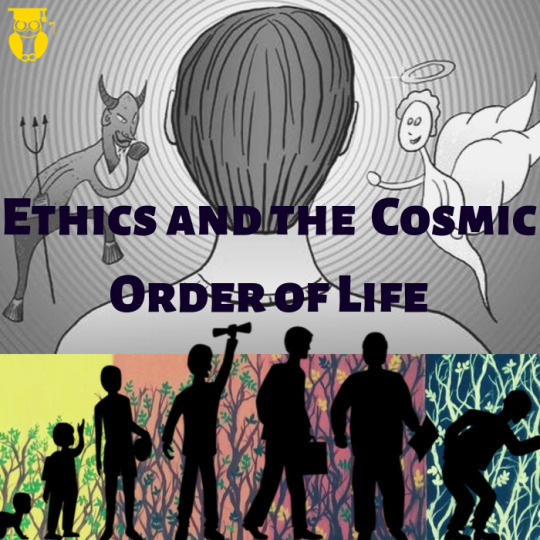
What is Ethics?

Ethics also called Moral Philosophy is usually regarded as the the discipline dealing with what is good and bad, and the difference between moral duty and obligation. It is the study of righteousness and wrongfulness from the perspective of human actions, to attain wisdom. Ethics is a reflective study of human responsibility from which human's good or bad conduct can be scrutinized. In other words, it guides behavior, choices and actions, and turns them into a set of standards, based on which a society is built. The moral principles of a social or religious society or of an individual is sometimes allude to by the same word.
What kind of human behavior is evil or good?
What are the qualities of a good person?
How should one make a decision in life?
These are the fundamental questions answered by ethics.

The social and spiritual ways of life have its roots in the moral code and conduct. To live amidst earthly joys and sorrows is the true essence of human life. Righteousness emphasizes on moral virtues and values. People discharge their duties to comply with the moral code of ethics. There are thus two kinds of ethics:
Individual, and
Social
Individual ethics is indicative of good qualities for individual well-being and happiness. Social ethics represents those values which are necessary for maintaining social order and harmony.
The origin of ethics is in India's traditional, religious and philosophical thinking. Good moral conduct is essential in every religious tradition for a happy and contented life. No one can attain the supreme goal (salvation) of life without following the path of righteousness.
The Cosmic Order
In India, there is a very ancient history of thinking about ethics. Its central concepts is in Rigveda, one of the oldest sacred books of India

as well as of the world. The idea of an "all pervading cosmic order" is in Rigveda which signifies harmony and balance in nature and in the human society. Here, cosmic order is a central force or power that controls all the forces of nature and moral values of human society. Disturbing this harmony and

balance leads to disorder and suffering. This power or force keeps everything in balance and maintains the natural flow of the universe. The concept of cosmic order gave rise to the idea of Dharma in Indian tradition. The term Dharma here stands for duty, obligation, and righteousness rather than a mere reference to religion. Everyone should discharge his or her duty according to his social position and station in life. In Buddhism, Pali word Dhamma is used in place of Sanskrit word Dharma. There are sociological texts called Dharmshaastras that describe the guidelines and rules about what is thought as the appropriate behavior for human beings. These texts also discuss about duties and obligations for an individual as well as a member of the society.
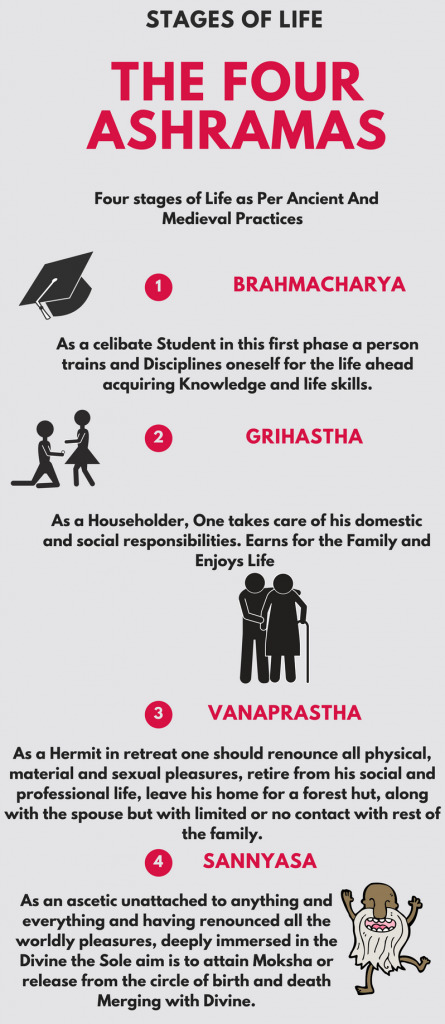
The Four Stages of Life
Goals and Stages of Human Life
In the Hindu way of life, every person is required to fulfill his or her duty appropriate to his or her caste in all the stages of his life. The Four stages of life and their respective dharma were designed to provide fulfillment to the person of social, moral as well as spiritual aspects leading to harmony and balance in the society. An Ashrama in Hinduism is one of four age-based life stages discussed in Indian texts of the ancient and medieval eras. The Ashrama system a component of the ethical theories in Indian philosophy, where it is combined with four proper goals of human life (Purusartha), for fulfillment, happiness and spiritual liberation. The four stages according to the Hindu way of life are,
Brahmacharya, Stage of studentship
Grihastha, Stage of the Householder
Vanaprastha, Life in the forest
Sannyasa, Renunciation
This very important concept of the Four ashramas of life is for the fulfillment of human aspirations through the Goals (Purusartha) which are desirable. Puruṣārtha literally means an "object of human pursuit". These goals are:
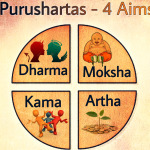
Righteousness, dharma
Worldly Gain, Artha
Fulfillment of desire, Kama
Liberation, moksha
For a human, all four goals of life are important. But in cases of conflict, Dharma is considered more important than Artha or Kama in Hindu philosophy. Moksha is considered the ultimate goal of the human life. From the ethical point of view, righteousness and liberation are the most important since they give right direction and purpose to life. For instance, acquiring wealth is a desirable objective but it can also serve righteousness, that is, welfare of the society.
Read the full article
#artha#ashrama#brahmacharya#conduct#cosmic#cosmic_order#dharma#dharmashaastra#ethics#grihastha#hinduism#human_beings#humanity#kama#life#moksha#moral_code#moral_duty#moral_philosophy#obligation#purusartha#righteousness#rigveda#sannyasa#social#soul#spiritual#tradition#vanaprastha#vedas
2 notes
·
View notes
Video
No one remembers the girl baby born on the same day who was interchanged with Krishna, a boy baby, to save his life. The boy's life was precious but the girl was born to sacrifice her life. Today is not only the birthday of Krishna but also of Yogamaya. It is said that Yogmaya flew off to Heavens freeing herself from the clutches of Kansa while announcing to Kansa that your killer has been born. Scriptures do not clearly mention that she too got killed like other siblings of Krishna. However more knowledgeable are requested to throw light on it. Yogmaya was also an incarnation of Shakti who came to be born along with the incarnation of Lord Vishnu to keep some old promise. When Kansa caught her by her feet and hurled her to the ground, she flew towards the heaven, saying “Kansa, your killer has already taken birth. I could have also killed you but since you caught me by my feet, I take it as your expression of humility and am pardoning you”. Krishna was born in the darkness of the night, into the locked confines of a jail. However, at the moment of his birth, all the guards fell asleep, the chains were broken and the barred doors gently opened. Similarly, as soon as Krishna ( Chetna, Awareness ) takes birth in our hearts, all darkness ( Negativity ) fades. All chains ( Ego, I, Me, Myself ) are broken. And all prison doors we keep ourselves in ( Caste, Religion, Profession, Relations etc ) are opened. And that is the real Message And Essence of Janmashtmi. Happy Krishna Janmashtami #janmashtmi #krishna #happy_birthday_krishna (at Krishna Consciousness) https://www.instagram.com/p/B1ilM76hGuY/?igshid=laonz0cog659
2 notes
·
View notes
Photo

The reason old souls enjoy spending time alone, is because they never really are...! #themodernvedic #solitude #love #nature #peace #photography #art #life #meditation #introverts #silence #travel #landscape #selflove #introvertlife #quotes #positivevibes #relax #beauty #poetry #relaxing #spiritual #introvert #mood #blackandwhite #introvertsparadise #subscriptionboxes #introvertproblems If you're lonely when you're alone, you're in bad company. #introvertsinbusiness #sky #introvertsofinstagram #loneliness #alone #photo #darkness #peaceful #awareness #wanderlust #introvertsretreatbox #introvertquotes #retreat #relaxation #introvertsunite #introvertedwomen #recharge #introvertsunitequietly #introvertstyle #introvertsguiltypleasure #hideaway #depression #introvertsareawesome #introvertsarepeopletoo 🦉🦉🦉🦉🦉🦉🦉🦉🦉🦉🦉🦉🦉🦉🦉🦉🦉🦉🦉 For more Visit http://www.themodernvedic.com 🦉🦉🦉🦉🦉🦉🦉🦉🦉🦉🦉🦉🦉🦉🦉🦉🦉🦉🦉 (at Lonely Planet) https://www.instagram.com/p/BzFKl0FBGFO/?igshid=1t8fdtcqur0o7
#themodernvedic#solitude#love#nature#peace#photography#art#life#meditation#introverts#silence#travel#landscape#selflove#introvertlife#quotes#positivevibes#relax#beauty#poetry#relaxing#spiritual#introvert#mood#blackandwhite#introvertsparadise#subscriptionboxes#introvertproblems#introvertsinbusiness#sky
1 note
·
View note
Photo

Shiva and Shakti are indistinguishable. They are one. They are the universe. Shiva isn't masculine. Shakti isn't feminine. At the core of their mutual penetration the supreme consciousness opens. #themodernvedic #shiva #mahadev #india #love #mahakal #hinduism #harharmahadev #om #shiv #bholenath #god #hindu #lordshiva #bhakti #omnamahshivaya #bhole #yoga #krishna #har #ganesha #ganesh #bholebaba #instagram #photography #ram #shivaay #spiritual #temple . Only when Shiva is united with Shakti does he have the power to create... #mahakaal #aghori #ganpati #omnamahshivay #meditation #jaimahakal #spirituality #bhfyp #ke #maharashtra #vishnu #travel #lord #shivshakti #mahakaleshwar #shivshankar #indian #ujjain #incredibleindia #yogi #insta #delhi #instagood #shambhu #devokedevmahadev #peace #divine In Hinduism, Shiva the Cosmic Dancer, is perhaps the most perfect personification of the dynamic universe. Through his dance, Shiva sustains the manifold phenomena in the world, unifying all things by immersing them in his rhythm and making them participate in the dance - a magnificent image of the dynamic unity of the Universe. 🦉🦉🦉🦉🦉🦉🦉🦉🦉🦉🦉🦉🦉🦉🦉🦉🦉🦉🦉 For more Visit http://www.themodernvedic.com 🦉🦉🦉🦉🦉🦉🦉🦉🦉🦉🦉🦉🦉🦉🦉🦉🦉🦉🦉 (at LORD SHIVA -destroyer of evil.) https://www.instagram.com/p/BzA72lmh6_k/?igshid=1hcqxd3tkzty5
#themodernvedic#shiva#mahadev#india#love#mahakal#hinduism#harharmahadev#om#shiv#bholenath#god#hindu#lordshiva#bhakti#omnamahshivaya#bhole#yoga#krishna#har#ganesha#ganesh#bholebaba#instagram#photography#ram#shivaay#spiritual#temple#mahakaal
32 notes
·
View notes